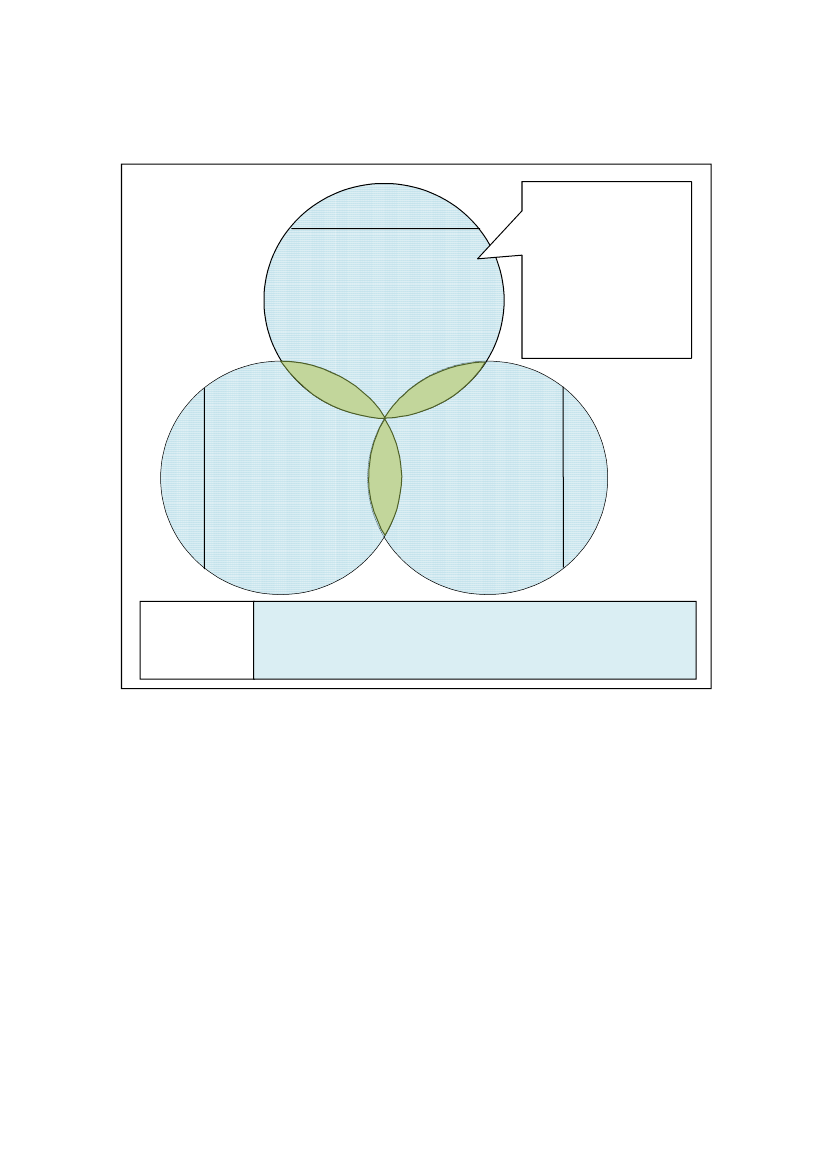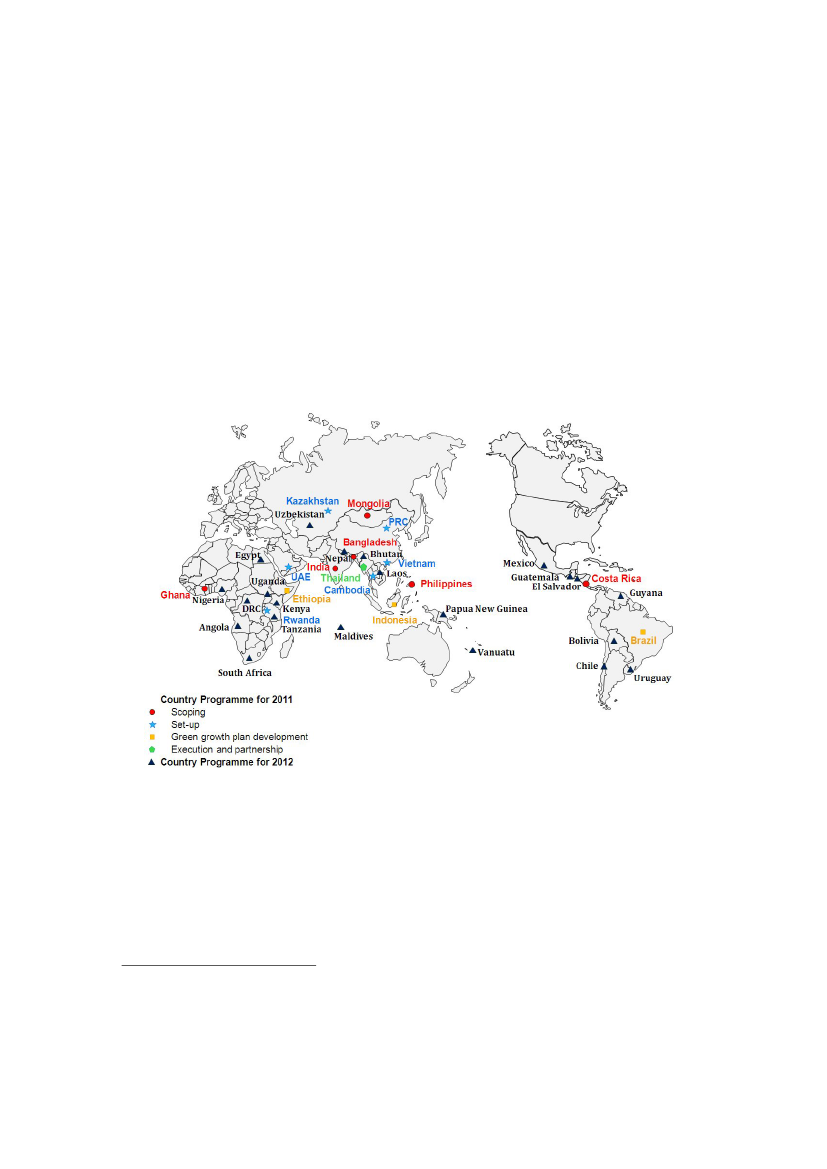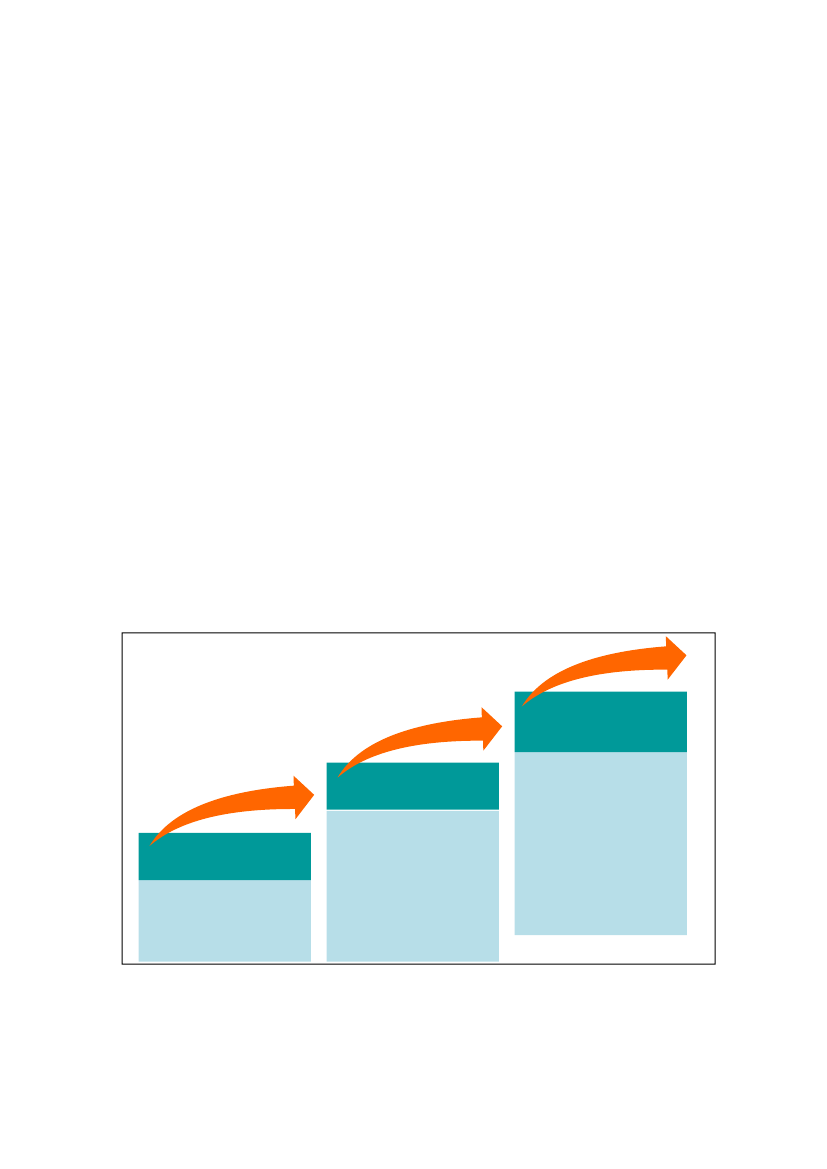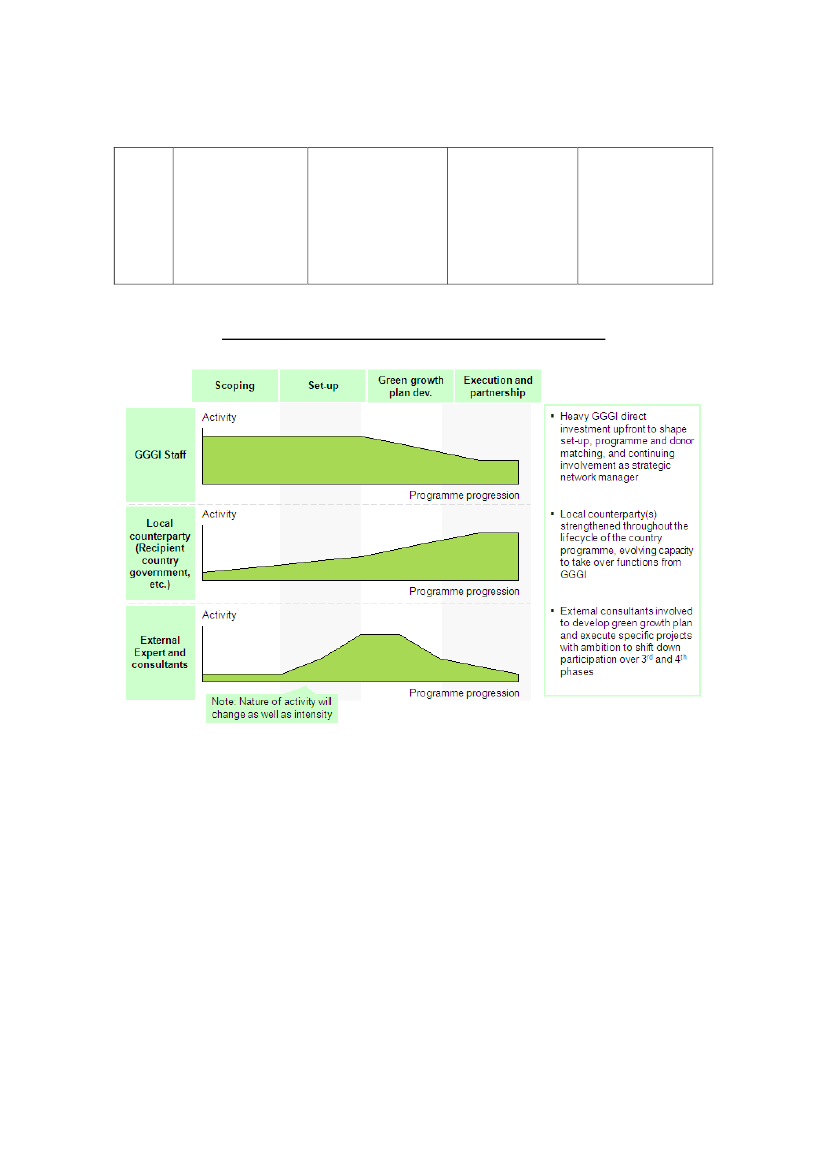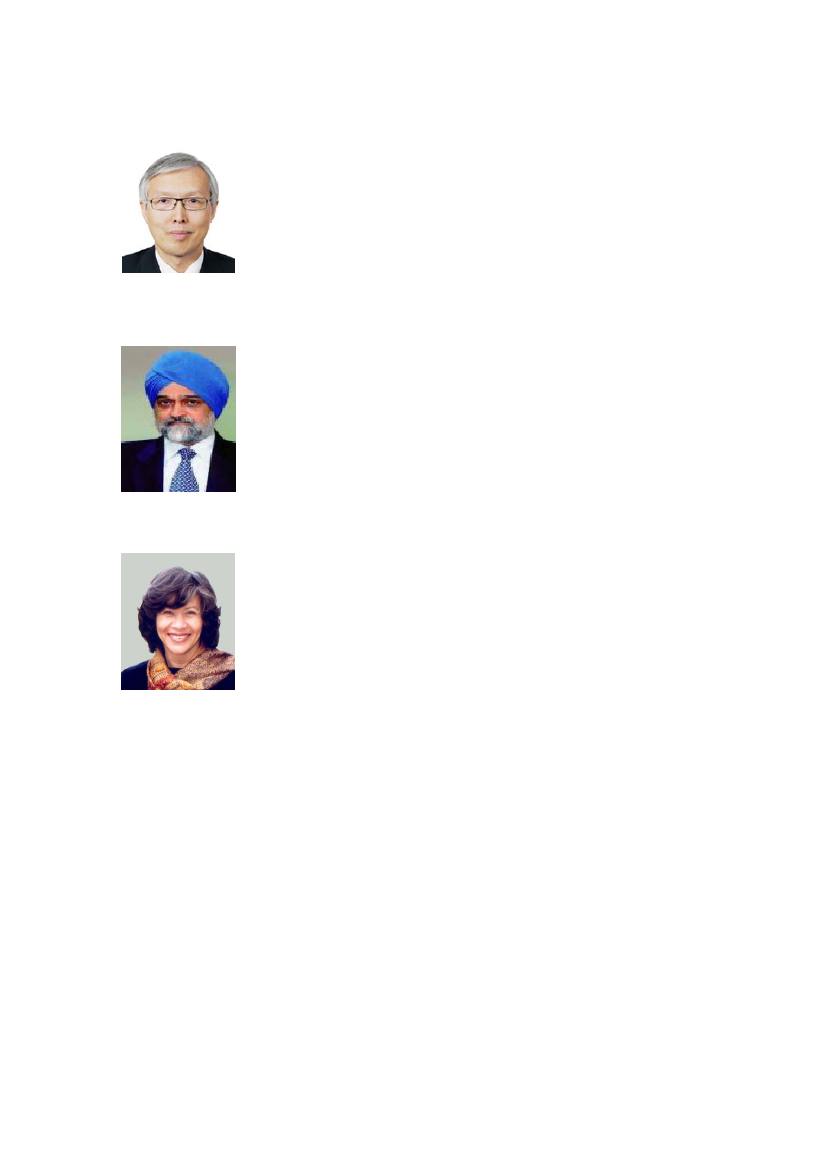Udenrigsudvalget 2013-14, Finansudvalget 2013-14, Klima-, Energi- og Bygningsudvalget 2013-14
URU Alm.del Bilag 42, FIU Alm.del Bilag 26, KEB Alm.del Bilag 74
Offentligt
Global Green Growth Institute (GGGI)Ministry of Foreign Affairs, (Danida), DenmarkMinistry of Climate and Energy, Denmark
FinalComponent DocumentSupport to the Global Green Growth Institute
Republic of Korea
February 2011
Executive SummaryProgramme Context and StrategyIt has been well-documented that previous anthropogenic activities especially on the partof developed countries are the cause of global warming. Centuries of industrialisation andhigh-carbon growth in some parts of the world now have global environmentalconsequences.1The poor countries are the most vulnerable to climate change since they have the leastresources to ensure successful adaptation. Furthermore, the dire environmental state ofthe Earth and the international climate change regime now require these countries todepart on alternative development paths to reduce the environmental impacts associatedwith previous models for development. One of the greatest challenges in the years tocome will be for developing countries to build the capacity to both adapt to the impacts ofclimate change and contribute to mitigation in the context of economic and populationgrowth and the fight against poverty.The linkage between green growth and poverty reduction is of paramount importance toGGGI. Therefore, GGGI is dedicated to supporting the creation and diffusion of a newmodel of economic growth, known as ‘green growth’ that integrates economic aims suchas poverty reduction, job creation, and social development, with environmental goalssuch as sustainability and climate and energy security.GGGI supports emerging and developing nations in their efforts to create and implementnational and local strategies and policies for pursuing green growth. In order to do so,GGGI carries out four core activities, i.e., Country Programmes, research and knowledge,network mobilization and management.Among the core activities, the Country Programme consists of key elements of GGGI’sactivities, including projects on Green Growth Plan (GGP) design, capacity building, andpublic/private partnership building. GGGI operates a tailored but consistent Programmefor each country, in which the GGP is typically comprised of four phases: scoping, set-up,GGP design, and execution and partnership. Following this process will build a solid andsubstantial foundation for green growth in the developing countries.A list of country selection criteria has been derived by GGGI to identify the mostappropriate partner countries in order to maximize the impact of the Programme outcomeand to ensure real influence on the ground by prioritizing the resources to the parts of theworld where it can have the greatest effect also considering the special needs of the lowincome countries. GGGI has tentatively selected 38 candidate countries for 2011 and2012 based on the criteria, including the three countries that have already been engagedsince 2010.Intergovernmental Panel on Climate Change, IPCC Fourth Assessment Report: Climate Change 2007,2007.1
ii
ObjectivesGreen growth refers to a set of strategies that aims for continued economic growth andenvironmental progress without sacrificing one or the other. It promotes sustainablegrowth which helps reduce greenhouse gas emissions and environmental pollution. It isalso a new development paradigm that stimulates new economic growth engines and jobcreation with green technology and clean energy.GGGI activities are centred on three main aims: (1) to promote the green growthparadigm by conducting research in green growth theory and practice (2) to disseminatethe research results around the world and (3) to provide support to developing countriesin their endeavours to develop their own green growth strategies that are feasible andwell-aligned with other national economic goals.Based on the above long-term objectives, GGGI is pursuing three immediate objectives,i.e., becoming a fully operating international organisation by 2010, conducting leadingresearch on green growth theory and models, and applying new development paradigmthrough Country Programmes.
OutputsGGGI has carried out three Country Programmes in Brazil, Ethiopia, and Indonesia since2010 and these will be continued in the next years. The programmes in their first phasehave produced significant outcome in initiating the GGP in those countries.One of the most significant aspects of the Country Programmes is GGP design andpartnership. GGGI’s approach facilitates high-level engagement as well as localpartnerships, which positively impacts the chances of effective implementation. Suchactivities encompass extensive and collaborative consultation with the relevantstakeholders both in the public and private sectors.Along with achieving significant outcome through the three Country Programmes, GGGIwas also able to draw lessons to take into consideration for more effective results in thefuture. For example, the importance of understanding recipient countries’ priorities byworking closely with governments for meaningful analysis and recommendations wasrecognized. In addition, GGGI was able to develop Performance Management Criteria toachieve high-level performance in conducting Country Programmes, as well as potentialstrategic implications for 2011.Together with the Country Programmes, GGGI aspires to create tangible and substantialoutputs for 2011 and beyond, namely, institutionalisation of GGGI; advancement indeveloping green growth theory and practices; and initiating a number of additionalCountry Programmes.Expected Impact of the Component Support
iii
The Danish support is expected to generate a considerable improvement in developingcountries’ ability to address and respond to climate change, through adaptation andmitigation in the context of sustainable economic development. Ultimately, this willimprove the living standards, health and welfare of the global population as a whole, notrestricted to the poorest and marginalized who are most adversely affected by current andfuture climate change and environmental degradation.BudgetThe Republic of Korea has committed to providing $10 million per year in 2010 for thenext three to five years and Denmark $5 million per year for 2011-2013. GGGI iscurrently in discussion with many other institutions and governments regarding fundingin future years. The most advanced discussions so far have been with the governments ofUAE, Germany and Japan.
iv
Category
Description
Detailed DescriptionKorea
2010(May-Dec)9,880,869--9,880,8695,217,391
201110,000,0005,000,00011,400,00026,400,000726,4002,000,0002,000,0002,000,0002,000,0001,500,0001,000,0001,000,0001,000,000
201210,000,0005,000,00027,500,00042,500,000500,0002,500,0001,500,0001,500,0001,000,0001,000,0001,000,0001,000,0001,000,0001,000,0002,000,0002,000,0002,000,0001,920,0001,500,000
201310,000,0005,000,00035,000,00050,000,000
201410,000,000-40,000,00050,000,000
DonorsIncome
DemnarkOthersTOTALCountry 1 (Brazil)Country 2 (Indonesia)Country 3 (Ethiopia)Country 4Country 5Country 6Country 7Country 8Country 9Country 10Country 11
500,0001,000,0001,000,0001,000,0001,000,0001,500,0001,500,0001,000,0002,000,0001,000,0002,000,0001,000,0001,500,0001,000,0001,500,0001,000,0001,750,0003,500,0002,000,0001,000,0001,000,0001,000,0001,500,0001,500,0001,000,0002,000,0001,500,00012,250,00024,750,000
CountryProgram
Country 12Country 13Country 14Country 15Country 16
Activities
Country 17Country 18
Expenses
Country 19Country 20Other CountriesTotalGreen Growth Research,ResearchTheory & Modelanddevelopment, DB Building,Knowledgeetc.Donor/recipientNetworkcountry/internationalMobilizationagency mobilization,partnership building, etc.GlobalStrategyGlobal Dissemination,Capacity BuildingSeoul HQOperationsBranch Offices(around 5)TotalTOTAL2,498,2619,880,8695,217,39113,226,40021,420,000
24,750,000
726,087
6,652,800
10,334,000
12,250,000
12,250,000
869,565
792,000
1,275,000
1,500,000
1,500,000
569,5652,498,261
3,432,0001,640,0001,000,0002,640,00026,400,000
5,221,0002,250,0002,000,0004,250,00042,500,000
6,500,0002,500,0002,500,0005,000,00050,000,000
6,500,0002,500,0002,500,0005,000,00050,000,000
* Income from the ROK in 2010 was calculated from KRW (South Korean Won) to US$ with 1 USD =1150 KRW
Management and OrganisationGGGI has initially been established as a non-profit foundation under Article 32 of theCivil Code of the Republic of Korea on 16 June 2010. The aim is for GGGI to later beconverted into an international organisation in accordance with agreements between themajor contributing governments.The organisational structure of GGGI consists of the Board of Directors; FacilitativeCommittee of the Board of Directors; Management committee; Advisory Council;Auditors; Headquarters and Regional Offices.v
GGGI’s management will be performed according to the principles of transparency,global partnership, results-oriented accountability and credibility.GGGI will manage and organize its works by building partnerships with variousorganisations around the world, who share the goals of sustainable development andintegrity. In this line of efforts, multiple MOUs have already been concluded with morein discussions.Especially for its Country Programme and Research Programme, GGGI works in an‘open architecture’ that embraces public/private organisations in both donor and recipientcountries. GGGI emphasizes mobilisation of expert network, engaging externalinternational and local consultants, secondees from donor and recipient countries andrepresentatives from international organisations, in addition to internal GGGI expertise.GGGI sees great value in involving the Danish expertise in its area of expert networkmobilisation in a formalised manner.Financial ManagementThe financial management of GGGI will follow internationally accepted rules andregulations in accordance with Korean law. The auditing will take place in alignmentwith GGGI’s rules. According to its articles of incorporation, GGGI shall be audited byan independent external audit organisation entrusted by the auditors of GGGI. Regardingthe matters of donations, GGGI will make available to the public the annually collectedamount of donations and the uses thereof on its website.Reporting, Monitoring, Reviews and EvaluationGGGI, according to its policy and terms, will annually implement internal review andfinancing auditing of its activities. The report will be available to the Donor ConsultativeGroup (DCG). It should include, but not exclusively, previous year’s progress,performance and expenditure in comparison with GGGI’s initially establishedplans/budgets.The DCG may conduct its own output review and financial auditing after 2.5 yearsstarting from 2011. For this process, experts from participating donor and recipientcountries will be invited to partake.Key Assumptions and RisksThere are three key assumptions that underlie this proposal for support: 1) increasing orsustained interest in the green growth facilitates GGGI’s institutionalisation; 2)networked by Regional Offices, GGGI will be successfully converted into a fulloperating international organisation by 2012; 3) GGGI’s well-established GGPs will besuccessfully applied to the recipient countries.The two main potential risks are GGGI’s successful transition into an intergovernmentalorganization and securement of solid and effective implementation of GGP. In order to
vi
minimize the occurrence and impact of possible risks, GGGI identified mitigationmeasures for each potential risk.
vii
Table of ContentsTable of Contents..................................................................................................... viiiAbbreviations........................................................................................................... viii1 Background and strategy for the support .................................................................. 11.1 Programme Context and Strategy1.2 Country Programme2 Objectives ..................................................................................................................... 112.1 Long-term Objectives2.2 Immediate Objectives2.3 Focus of Danish Fast Start Climate Financing3 Outputs......................................................................................................................... 143.1 Three County Programmes Conducted in 20103.2 Implications for 2011 and Beyond3.3 Expected Outputs of GGGI in the Future4 Contribution to cross-cutting issues and priority themes ....................................... 194.1 Poverty Reduction4.2 Gender4.3 Environment4.4 Governance4.5 Expected Impact of the Component Support5 Budget........................................................................................................................... 216 Management and organisation................................................................................... 226.1 Organizational Structure6.2 Transition into an Intergovernmental Organisation6.3 Management6.4 Guiding Principles6.5 Partnerships/Implementing Agencies6.6 Management and Organisation Procedures7 Financial management and procurement ................................................................. 327.1 Financial Auditing8 Reporting, monitoring, reviews and evaluation ....................................................... 338.1 Guiding Principles8.2 Reporting8.3 Monitoring8.4 Review and Evaluation8.5 Indicators
viii
9 Key assumptions and risks ......................................................................................... 389.1 Key Assumptions9.2 Potential Risks and Mitigation Measures10 Component Implementation Plan............................................................................ 41
ix
AbbreviationsADBCDMDANIDADCGDEAEBRDGEFGGGIGGPGHGIEAIETIGGWGIPCCLCGLDCsMRVNAMANAPAOECDPRSPSIDSUNUNECAUNEPUNESCAPUNFCCCVCMWBAsian Development BankClean Development MechanismDanish International Development AgencyDonor Consultative GroupDanish Energy AgencyEuropean Bank for Reconstruction and DevelopmentGlobal Environment FacilityGlobal Green Growth InstituteGreen Growth PlanGreenhouse gasesInternational Energy AgencyIndependent Evaluation TeamInter-ministerial Green Growth Working GroupIntergovernmental Panel on Climate ChangeLow Carbon GrowthLeast Developed CountriesMeasurable, Reportable and VerifiableNationally Appropriate Mitigation ActionNational Adaptation Programs of ActionOrganisation for Economic Cooperation and DevelopmentPoverty Reduction Strategy PaperSmall Island Developing StatesUnited NationsUnited Nations Economic Commission for AfricaUnited Nations Environment ProgramUnited Nations Economic and Social Commission for Asia andthe PacificUnited Nations Framework Convention on Climate ChangeVoluntary Carbon MarketWorld Bank
x
1
BACKGROUND AND STRATEGY FOR THE SUPPORT
It has been well-documented that previous anthropogenic activities especially on the partof developed countries are the cause of global warming. Centuries of industrialisation andhigh-carbon growth in some parts of the world now have global environmentalconsequences.2The poor countries are the most vulnerable to climate change since they have the leastresources to ensure successful adaptation. Furthermore, the dire environmental state ofthe Earth and the international climate change regime now require these countries todepart on alternative development paths to reduce the environmental impacts associatedwith previous models for development. One of the greatest challenges in the years tocome will be for developing countries to build the capacity to both adapt to the impacts ofclimate change and contribute to mitigation in the context of economic and populationgrowth and the fight against poverty, including expanding the access to affordable,reliable energy services to the poorest population groupsAccording to the IPCC, greenhouse gas (GHG) emissions could rise by 25 - 90 % by2030 relative to 2000 causing the Earth’s temperature to increase as much as 3˚Cby theend of this century. Even a 1 - 2.5˚Ctemperature rise would likely cause reduced cropyields in tropical areas leading to increased risk of hunger, spread of climate sensitivediseases such as malaria, and increasing the risk of extinction of 20-30% of all plant andanimal species. By 2020, up to 250 million people in Africa could have significantlyreduced access to water.3As such, adverse climate conditions have the potential toprofoundly impede the achievement of the MDGs, especially in relation to eradicatingextreme poverty and hunger, reducing child mortality, combating major diseases, andensuring environmental sustainability.4With the recent economic crisis, green growth is gaining support as a way to pursueeconomic growth and development, while preventing environmental degradation,biodiversity loss and unsustainable resource use. It builds on existing sustainabledevelopment initiatives in many countries and aims at identifying cleaner sources ofgrowth, including seizing the opportunities to develop new green industries, jobs andtechnologies, while also managing the structural changes associated with the transition togreener economy.5
Intergovernmental Panel on Climate Change, IPCC Fourth Assessment Report: Climate Change 2007,2007.3United Nations Framework Convention on Climate Change, Climate Change: Impacts, Vulnerabilitiesand Adaptation in Developing Countries, 2007.4United Nations Development Programme, Accelerating Progress towards the Millennium DevelopmentGoals: UNDP’s Work in Environment and Sustainable Development, 2010.5Organisation for Economic Cooperation and Development(OECD), Interim Report of the Green GrowthStrategy: Implementing our commitment for a sustainable future, 2010.
2
1
While the agenda in international forums such as the UN, G20, OECD and themultilateral banks have shifted to an increased emphasis on green and sustainable growthduring recent years, translation of the ideas of green growth into actual action plans forgovernments to pursue has been lacking. Moreover, even though many countries acceptthe green growth initiatives as their own, the recent increasing interest in green growthhas largely been concentrated on the concerns of advanced countries.The priorities for developing countries are still sustainable economic development,poverty eradication and delivering essential services such as water supply and energy, etc.At the same time, their economies are often dependent on natural resources renderingthem particularly vulnerable to the impacts of climate change. Nevertheless, developingcountries could often take a more proactive approach to climate action, actively seekingto enhance related benefits in terms if economic growth, job creation etc. This is one ofthe main reasons why GGGI is particularly interested in green growth, which promotesmitigation and adaptation measures while at the same time addressing poverty reductionand development and enhances the development potential of developing countries. Thelinkage between green growth and poverty reduction is of paramount importance toGGGI.1.1Programme Context and Strategy
GGGI is dedicated to supporting the creation and diffusion of a new model of economicgrowth, known as ‘green growth’ that integrates economic aims such as povertyreduction, opportunity creation, and social development, with environmental goals suchas sustainability and climate and energy security. GGGI is founded on the belief thatgrowth and environmental sustainability are not merely compatible objectives, but aremutually necessary for the future of humankind.GGGI’s activities are in full concurrence with the objectives of the Danish ClimateEnvelope to focus on quick win climate change mitigation and adaptation initiatives,while building capacity in developing countries in relevant sectors such as transformationof the energy and transport sectors toward higher efficiency and less dependency on fossilfuels, as well as other relevant sectors such as forestry and agriculture, i.a. by buildingcapacity in developing countries to plan for and develop towards a low-carbon economy.GGGI’s activities and its innovative approach based on networks and public-privatepartnerships meet the demands flowing from international negotiations and consultationson climate change and the promotion of green growth solutions, not least for thedeveloping countries. The institute represents a novel and innovative contribution to theinternational endeavours on climate change and green growth, tying together stakeholdersfrom government, research, international organisations and the public sector providingnew possible pathways to enable developing countries’ transition to low-carboneconomic growth.Furthermore, the Republic of Korea’s own recent development experience and its activeparticipation in South-South cooperation provides GGGI with an interesting platform forenhanced dialogue with the partner countries. The Republic of Korea’s incredible
2
economic growth over the last half century and the more recent decision to transition to agreen economy encourages partner governments to solicit the support of GGGI. Throughthe network approach of GGGI, the institute is able to add best practices and experiencesof all countries, also donor countries, to the catalogue of policy options available to thepartner government, hence adding an additional dimension to the South-Southcooperation model.GGGI supports emerging and developing countries in their efforts to create andimplement national and local strategies and policies for pursuing green growth. In sodoing, GGGI seeks to contribute to increasing the effectiveness and impact of nationaland local action on green growth, promoting best practice, building capacity, increasinginformation sharing, and encouraging international cooperation. Through its work, GGGIwill help advance both the theory and practices of green growth.To support its strategy, GGGI comprises of four core pillars, i.e., Country Programme,research and knowledge, network mobilisation and management.Country Programme: It focuses on how Country Programmes are managed andindividual projects are executed. Through Country Programs, the recipientgovernments will receive the support they need most and GGGI will ensure that itserves as a trusted advisor dedicated to recipient countries with primary goal toadvance their green growth agenda.Research and knowledge: It is dedicated to how GGGI’s research is initiated,managed and disseminated. In addition to Country Programmes, GGGI executesresearch programmes on green growth theory, models, methodology and tools.Research outputs will be shared through publications, conference, etc.Network mobilisation: It aims for GGGI’s partnership building with its partnersand funders who include donor countries, recipient countries, internationalagencies, academia and private sectors. Firm partnership with relevant groupsfrom public and private, global and local arenas enables GGGI to expandavailability of core funding and effective communication as well as efficientknowledge development.Management Systems: It focuses on how GGGI’s activities are efficientlysupported internally. GGGI pursues to be a professional organisation with strongperformance culture. It retains and motivates talented staff members, which isprerequisite to reinforce its in-house capacity and to enhance performance of itsactivities.
3
Figure 1. Four Core Activities of GGGICountryProgramme▪▪▪▪Scoping processesSet-up processesGGP development processesExecution and partnershipprocessesCountry Programmeincludes projects ona) GGP designb) Capacity buildingprojectsc) Public/privatepartnershipstogether with periodicreviews
▪Research andknowledge creation▪Research andknowledgemanagement▪Research andknowledgedissemination
▪Donor mobilisation▪Recipient countrymobilisation▪International agencymobilisation▪Academic networkmobilisation▪Private sectormobilisation
Researchand Knowledge
Networkmobilisation
1.2
1.2.1
Managementsystems
Country Programmedirection setting & Board of▪StrategicGreenDirectors (BOD) meeting preparationGrowthPlanning and budgeting▪Plan (GGP) Design▪Performance management
▪Talent management / HR▪Management of contracts▪External reporting / auditing
Among the above core pillars, the Country Programme consists of key elements ofGGGI’s activities and significantly impacts other activities. It includes projects on GreenGrowth Plan (GGP) design, capacity building and public/private partnership building.GGGI operates a tailored but consistent programme for each country which runs fromanalysis to implementation and is delivered through a portfolio of policy options.As for GGP design, GGGI develops GGPs by request of the recipient countries. Itstipulates green growth strategies, that is, national and local strategies that meet both theeconomic and environmental development. Not only is GGP an excellent tool of low-carbon green growth for advanced countries, it is also suited for developing countriesbecause it places priority on the growth aspirations of the developing countries beyondclimate concerns.The precise scope of work for a GGP in each country will depend on the startingconditions and specific challenges. At the most general level of GGP design, GGGIconducts a comprehensive diagnosis on a country’s green growth potentials and itsinternal and external challenges. The diagnosis involves assessing the territorial andsocio-economic conditions as well as the potentials in aligning development needs with
4
required actions to avoid irreversible impacts of climate change. Based on the result ofthe diagnosis, GGGI suggests the country’s vision on green growth, refine the policyoptions available for the GGP and detail the implications for implementation in thecontext of the broader green growth strategy. More specifically, GGGI seeks nationalalignment around priority sectors and prepares the green growth implementation roadmapfor the recipient countries. While energy security/efficiency, water, resourcesmanagement, green technology and industries, green infrastructure and city areconsidered as critical sectors in green growth, each GGP has its own priority sectorsaccording to the country’s individual situation and needs.Table 1 shows the whole lifecycle of a Country Programme, comprised of four phaseswhich are scoping, set-up, GGP design, and execution and partnership phases.Table 1. Typical Lifecycle of a Country ProgrammeGGP DevelopmentExecution andScoping PhaseSet-up PhasePhasePartnership PhaseEstablishrelationships withkey stakeholders,ensure sharedagreement on theprogramme’s high-level scope, andobtain high-levelgovernment buy-inIdentify localcounterpartyAllocate basicGGGI resourcesPut preliminaryMOU/contacts inplaceDetermine detailedDevelopment of aprogramme of workcomprehensive/with country andsectoral GGP for thecapacity buildingcountry and regularmodelreview of theprogressCreate formalsteering committeeBuild local capacity,of key stakeholderswith long term goalof transition toEnsure localindependent deliverycounterparty(s) setBuild strongup for successcommitment fromConsult with widerrecipient countryinternationalgovernment on thecommunity toimplementation ofmaximisethe GGPcoordinationAllocate budget andsecure final MOUDetailed agreement of Completion ofwork to be done withcountry’s GGPGGGI, resources todeliver it, and set-up oflocal counterpartyGGP implementedover time, includingdetailed road mapsTransfer skills to localstakeholders so theycan implement growthplans independentlyConducive policyframework aroundGGP put in place tostimulate privatesector investmentflowsRecipient countrybecomes a knowledgeand capacitycontributor to GGGIand its partnersRecipient countryimplements its GGPindependently, andcontributes content toGGGI’s network
MainPoints
Initial relationshipbuilding andexploration ofOutcomeopportunities with anew recipientcountries
GGGI Country Programme’s strong suit is its emphasis on and attention to building asolid and substantial foundation for green growth in the developing countries, whichensures the prolonging impact of the GGP throughout the course of green development inthe recipient country for many years to follow. This is the reason why the lifecycle of aCountry Programme covers Execution and Partnership phase.By analysing the obstacles of developing countries’ efforts in green growth policies,GGGI has identified the following four elements that are crucial to secure the continuous
5
implementation of GGPs proposed by GGGI, namely institutionalization, developmentand diffusion of technology, capacity building, and financing.First, a GGP proposes an institutional building process for its implementation. Thelegislative designing and the institutional arrangement for executing suggested policiesserves as a national framework on green growth. This allows the policy to be integratedinto the whole national policy system and further secures continuous efforts in nationaland local levels. It constitutes also the stakeholders’ capacity building of the recipientcountries.Second, as factual evidence demonstrates that green technological innovations will enablethe LDCs to leapfrog in their development process, GGP prioritizes the development anddiffusion of suitable green technology as a key element. Green technology provides acombination of benefits, including enhanced energy security and diffusion, reduced CO2emissions and lower energy costs. Efficient transport technologies and energy sectors willbe areas of importance as well. GGGI will encourage a technology platform tailored toeach recipient country’s development needs and circumstances.Third, a GGP includes significant capacity building to allow the recipient country tofurther develop and implement the plan independently and become a content contributorto GGGI’s network, able to assist in capacity building for other countries. Capacitybuilding constitutes the base by which LDCs can sustain any GGP. GGGI’s work oncapacity building mobilizes both international and local experts which will create acollaborative base with relevant stakeholders, from high-level public officials to civilsociety.Fourth, without appropriate financing, implementation of GGP may not be efficient.Financing is vital for the implementation of the GGPs proposed by GGGI. Conducivepolicy framework around GGP should stimulate private sector investment flows. Parallelto its support on the institutionalization of proposed measures under the GGP, GGGI willassists in the mapping of various potential funding sources and facilitate contact betweenrecipient governments and potential funding agencies.1.2.2Strategy for Engaging the Recipient Countries
Selecting the right partner countries to collaborate with is critical to maximizing thechances of actualizing the expected outcomes and to ensure real impact on the groundmentioned in Table 1. Given the rapid, on-going lock-in of carbon-intensiveinfrastructure and the risk that climate change poses to all nations, GGGI will prioritizeresources to the parts of the world where it can have the greatest effect, while at the sametime ensuring that LDCs are also targeted for support. The thirty largest developing andnewly industrialized emitters comprise nearly half of the current global emissions.Reducing global emissions to a level in line with global targets requires that lock-in ofcarbon-intensive technologies is avoided in these countries, many of which are regionaland global leaders.
6
In parallel, GGGI believes that the country’s political leadership is the most importantfactor to successfully shift a country’s economic paradigm toward low emissiondevelopment path. For example, GGGI requests the participating governments to createthe conditions where recommendations have real impact on policy. GGGI should beinvited by a participating government to provide support, and there should be a clearlyidentified unit within the governments to receive the support and work closely withGGGI. If the GGP is designed for a regional or local government, the nationalgovernment level support should be ensured.In addition, there are a number of additional criteria that are very important, includingregional and income-level diversity, poverty reduction potential and others. GGGI willfirst conduct a preliminary prioritization exercise, in order to select, jointly with donorcountries and organisations, the future recipient countries it intends to work with on thebasis of a number of criteria numerated in Box 1.6
6
Some of the Country Programmes will be carried out looking at the country’s green growth related planswhere such exists; some will scale up the section of the country’s Poverty Reduction Strategy Paper (PRSP)or their National Adaptation Programs of Action (NAPAs). Annex 1 is the snapshots of some countries’plans relevant to climate change and green growth.
7
Box1. Country Selection Criteria1. GDP Level and Poverty Reduction PotentialGGGI gives more priority to poverty reduction and increase in the recipient country’s GDPas an output of its GGP.While growth is important in a country’s development, how does a GGP reduce emissionsand at the same time have tangible job creation potential?Will the vulnerability to climate change impacts and the livelihood support of this country begreatly affected if a GGP is not implemented?2. Country’s Need Specific InitiativeA GGP should reflect existing needs and initiatives of the recipient country.3. Regional and Political StabilityGGGI is a global institution and thus does not favor any particular region or country.Can this country’s GGP offer insight into green growth pathways for other countries thathave similar geographic or sectoral locations?Is the political environment conducive for Country Programme activities?4. Capacity Building and PartnersAre there sufficient country capabilities to develop and execute a robust GGP or is outsideassistance necessary?What additional value will GGGI bring to this country?Are there proper government institutions and agencies to support GGGI’s projects?What previous and on-going projects with donors and international agencies exist in thiscountry?5. GHG Emissions and related mitigation potentialWhat is the current level of GHG emissions associated with economic activities and landuse?Does a GGP offer the country an opportunity to avoid a lock-in of carbon-intensiveinfrastructure development?Does the country have an existing database, or how difficult will the collection of data for acredible analytic process be?What are projected emissions and related mitigation potentials in different sectors?GHG data by sectors and sources, per capita emissions, energy intensity(toe/F$1,000), carbonintensity (tCO2/$1,000).6. International ContextWhat kind of influence does the country have on the broader regional and global landscape?Is the country a member of major international conventions and regimes?What is the country’s FDI related framework?How is the country evaluated by international institutions?7. Domestic Policies and LegislationsWhat kinds of policies or legislation are in place regarding green growth such as RE &EE,forest management, etc.?
8
8. Potential InfluenceWhat is the impact of assistance to the country's overall development plan and strategies?To what extent can the outcome be replicated in other sectors or countries?
1.2.3
Candidate Countries for the Period 2011-2012
9
In the beginning of the year 2011, GGGI tentatively selected 38 candidate countries forthe next two years (See Figure2 below). Including the three countries that have alreadybeen engaged since 2010, GGGI will more likely to conduct country programmes in thefollowing countries:Central & Mainland Asia (4): Bangladesh, Kazakhstan, Mongolia, PRCAfrica (3): Ethiopia, Rwanda, GhanaSouthwest Asia (1): UAESoutheast Asia (6): India, Indonesia, Cambodia, the Philippines, Vietnam,ThailandMiddle & Latin America (2): Brazil, Costa Rica7Figure 2. Candidate Countries for 2011-2012
Acquiring experience in different continents and countries will contribute to creating atruly global and diverse knowledge base at GGGI. The candidate countries were selectedaccording to diversity along geographies, demand of recipient countries and partnershipbuilding progress with GGGI. The country list is open to further discussion and willultimately be decided by means of additional expert dialogues as well as by conductingmore in-depth analytical research in 2011. The final approval of countries will be madeby the Board of Directors.
7
As of January 2011, there are 6 countries in the Scoping Phase: The Philippines, Mongolia, Bangladesh,India, Ghana, Costa Rica; 6 in Set-up Phase: UAE, Kazakhstan, China, Cambodia, Vietnam, Rwanda; 3 inGGP Development Phase: Brazil, Indonesia, Ethiopia; 1 in Execution and Partnership phase: Thailand.
10
22.1
OBJECTIVESLong-term Objectives
Integrating environmental and climate change concerns with poverty reduction and socialdevelopment strategies and plans, green growth refers to a set of strategies that aims forcontinued economic growth and environmental progress both at the same time. Itpromotes sustainable growth which helps reduce greenhouse gas emissions andenvironmental pollution. It is also a new development paradigm that stimulates neweconomic growth engines and job creation with green technology and clean energy.GGGI activities are centred on three main aims: (1) to promote the green growthparadigm by conducting research in green growth theory and practice (2) to disseminatethe results of this research around the world and (3) to provide support to developingcountries in their endeavours to develop their own green growth strategies that arefeasible and well-aligned with other national economic and climate change related goals.As Seoul Declaration of G20 Seoul Summit 2010 has clearly stated, the recent economiccrisis disproportionately affected the most vulnerable in the poorest countries and slowedprogress toward achievement of the Millennium Development Goals. Narrowing thedevelopment gap and reducing poverty were integral to achieving the G20’s Frameworkobjectives of strong, sustainable and balanced growth. As a leading internationalorganisation in green growth, GGGI wants to use its best efforts to contribute to globalrebalancing as well as a rapid increase in the developing countries’ share of globalgrowth.Based on the above stated long-term objectives, GGGI is pursuing the three followingimmediate objectives.
2.2
Immediate Objectives
1) InstitutionalizationGGGI seeks to scale up and expand its activities to become a fully operatinginternational organisation by 2012. While securing GGGI’s financial resourcesfrom multiple donors’ participation, GGGI will enlarge the Board of Directorsfrom major donors, senior development country officials and international experts.By 2014, GGGI has a plan to newly establish around five Regional Offices,including Copenhagen office, to enforce its in-house capacity and global network.2) ResearchAs a global leader of green growth, GGGI will contribute to advance the technicalmethodology of green growth especially for developing and least developedcountries through its Research and Global Strategy activities. GGGI will produce
11
reports on green growth theory and models, organize conferences and workshops,and assist countries in their efforts to strengthen capacity and partnership building.3) Country ProgrammesCountry Programmes conducted in the up-coming years by GGGI will be the firstand foremost cases where the green growth model is practically applied to theLDCs as a new development paradigm. As a practical response to climate changeand poverty reduction, GGGI’s country engagement will be tailored to LDC’sneeds, employing the most suitable methodology for each country.2.3Focus of Danish Fast Start Climate Financing
The focus of Danish Fast Start Climate financing is on quick win climate changemitigation and adaptation initiatives in relevant sectors such as transformation of theenergy and transport sectors toward higher efficiency and less dependency on fossil fuelsnot least in the poorest countries. Other relevant sectors are also targeted, such as forestryand agriculture which are relevant both from a mitigation and adaptation perspective. Animportant area of support is the building of capacity in developing countries to plan forand develop towards a low-carbon economy, develop adaptation strategies, and enhancetransparency of action undertaken.Danish Fast Start financing prioritizes the participation of the private sector and civilsociety in developing countries, as close collaboration between the public and privatesectors is a precondition for reaching climate change mitigation and adaptation targets.The support by the Danish government will assist GGGI’s activities in LDCs as well as inemerging economies with considerable mitigation and demonstration potentials. Fundingwill primarily be directed towards initiatives within sectors that are relevant to emissionsmitigation (such as energy and transport) and/or climate sensitive sectors and therefore inneed of adaptation (such as agriculture, forestry and water).In supporting GGGI, the Danish government will facilitate the development and sharingof green growth models combining environmental concerns and climate change issueswith poverty reduction and social development. GGGI’s research activities as well asdissemination of best practices within these areas will further underpin Denmark’songoing and future bilateral environmental programmes in partner countries.The priorities guiding the Danish fast-start financing are well reflected in the GGGI’sbroader objectives. At the same time, it is noted that the GGGI objectives correspondwell with key priorities set forth in the strategy for Denmark’s development cooperation(FREEDOM from POVERTY - FREEDOM to CHANGE), which emphasizes that globalsustainable development requires solutions to crucial environment and climate issues andthat economic growth must be combined with environment and climate-friendlydevelopment in order to be sustainable.
12
The strategy furthermore states that to help facilitate sustainable development“[W]e willsupport growth strategies based on low energy solutions and initiatives that improve thecountries’ chances of participating in the international CO2 market. Climate friendlytechnology can lead to increased employment and Denmark will support developingcountries’ efforts to take advantage of this potential.“With the expected increase in GGGI Country Programmes, Denmark and GGGI couldfurther down the line cooperate directly on specific projects or elements under the GGP’sof countries where Danish development assistance is targeted. Potential countries forsuch first joint efforts could be Indonesia, Ghana, Tanzania, Bangladesh, Nepal orCambodia – Indonesia is already a GGGI partner country and the remaining countries areall in GGGI’s pipeline.
13
33.1.
OUTPUTSThree Country Programmes Conducted in 2010
In 2010, GGGI has officially launched and started its activities such as CountryProgramme and Research Programme. Besides its active participation in relevantinternational events on green growth, GGGI has carried out three Country Programmes inBrazil, Ethiopia and Indonesia. The projects being in their first phase have significantoutcome in initiating the GGP in those countries. GGGI has codified existing greengrowth and development aspirations, and prioritized green growth opportunities based onthe detailed, sector by sector analysis and their impact on green growth.3.1.1Programme Summary
In Brazil, preliminary analysis has been carried out to support the definition of lowcarbon options for all key GHG emitting sectors, develop a climate adaptation strategyand assist in the efforts of developing a carbon financing framework for the country. Theproject started in July 2010 and the first phase of the low carbon sector diagnostic in theforestry, agriculture, steel and electricity sectors were analysed.In Ethiopia, analysis using the available data has been carried out in 2010, in the energy,agriculture and forestry sectors with the intention to seize the opportunities for CO2-eabatement in each of the three priority sectors on the basis of the best and most recentdata currently available.In Indonesia, GGGI is supporting the provincial government of East Kalimantan to createa fact base on emission sources and potential reduction opportunities. The governmentidentified the possible CO2-e abatement sectors in phase one of 2010 and there is an on-going analysis of the green growth strategy in the oil, gas, coal, agricultural, palm oil andforestry sectors.3.1.2GGP Design and Partnership
One of the most significant aspects of these projects is that they involved an extensiveand collaborative consultation with the relevant stakeholders both in high-level and inlocal primary partner institutions. GGGI’s approach in conducting the CountryProgramme is based on local interaction as it facilitates high-level engagement, know-how transfer, capacity building and local buy-in which positively impact the chances ofimplementation of the project.High-level buy-in and relationship building: All three Country Programmesconducted in 2010 were mandated by the recipient governments and have workedextensively with the key ministries and government institutions which woulddrive the implementation; Brazil project was mandated by the Ministry of Finance,Indonesia project by the Provincial Government of East Kalimantan, and Ethiopiaproject was mandated by the Prime Minister, who endorsed the project.
14
Particularly, in Ethiopia, GGGI created inter-ministerial working group meetingsthat review the work regularly to ensure the project does not fall off-course.Participation of local partners: All Country Programmes conducted in 2010closely engaged many local partners; Brazil project had a local partnership withEMBRAPA, IPEA, INPE, EPE and etc., Ethiopia project with the EthiopianDevelopment Research Institute (EDRI), and Indonesia project with REDD TaskForce, Central Kalimantan and Kaltim Green Team. Importantly, local partnershad frequent interactions with GGGI. For example, GGGI team held training ofgovernment officials in Ethiopia, community workshop for local farmers inIndonesia and stakeholder consultation on forestry project in Brazil. In Ethiopia,GGGI team held two half-day workshops attended by roughly 40 people, each inwhich participants provided valuable input and expressed real enthusiasm tocontinue to work with GGGI team.3.1.3Lessons from the 2010 Programmes
Through the three Country Programmes conducted in 2010, GGGI has achievedsignificant outcome in developing low carbon GGP, however, there were also lessons totake into consideration for more effective results of the Country Programmes in thecoming years.GGGI team has learned that understanding recipient countries’ priorities andaspirations by working closely with governments is the only way to ensure theanalysis and recommendations are relevant through the Programme duration.Right balance has to be achieved between comprehensiveness of the approach andadapting the analysis to governments' requirements.It was found that different projects were at diverse situation, causing difficulty toattain real recipient country governments’ ownership, e.g. in Indonesia it wassubtle to move away from the perception of GGGI as a donor rather than a co-owner of the project.While on-the-job capacity building was happening across projects, the lack ofstructure made it difficult to evaluate and scale/share with other projects.There is a potential trade-off between involving local partners (increasing thecapacity building element) and delivering output with speed and quality.3.2Implications for 2011 and Beyond
From the experience of conducting Country Programmes in 2010, GGGI has derivedPerformance Management Criteria as well as potential strategic implications for futureCountry Programmes.
15
3.2.1
Country Programme Performance Management Criteria
To achieve high level performance in conducting the Country Programme, GGGI hasdeveloped the following performance management criteria (See Table 2 below).Table 2. Performance Management CriteriaHigh-level Performance CriteriaDetailed Performance CriteriaQuality of country’s high levelAre targets/strategies based on robust andstrategy/green growth agendacomprehensive analysis generated by theGGGI project?Political support for green growthHave high-level officials been involved in theagendaproject over time?Has the project been supported by institutionsacross government?Design and development of greenAre sectoral policies based on the analyticalsectoral policiesresults of the project?Have the relevant agencies in governmentbeen directly involved in the project?Mobilisation of new resources forHas GGGI developed material which will begreen investmentsused to access public and private funds?Has GGGI create some direct connection topotential funders?Local capacity to implement greenHave the people in charge of implementinggrowth programmesthe plan been directly involved in itsdevelopment as team members?Have capacity building modules beendeveloped and rolled out during the project?Strength of local GGGI counterpartyHas the local partner contributed significantlyand country networkto the study?Has the local partner provided access to keystakeholders/networks?Specific transferability of theHas the team generated material that is easilyprogramme learning/experienceuseable by other teams in various countries?Has the knowledge created been captured andcodified for GGGI’s use?Quality of partnership/engagementIs the ownership of the project truly sharedwith wider GGGI systemwith GGGI?Has GGGI senior staff been involved directlywith the project through its duration?3.2.2Potential Strategic Implications for 2011
16
The following potential strategic implications for the Programmes in 2011 have been setup based on the lessons learned from the 2010 Programmes conducted in the threecountries.Creation of a local ‘steering group’ would strengthen and support the relationshipbetween recipient government and GGGI team.More frequent interactions with local partner institutions are required to ensureconsistency of methodology applied with GGGI’s approach.Stronger GGGI presence on the ground with deeper involvement in problemsolving/analysis as well as stakeholder management would enhance GGGI’sownership.Creation of specific training modules/tools explicitly built into projects isnecessary.GGGI should ensure secondments from local institutions to GGGI’s teams toincrease capacity and improve ownership of project by local partners.Regular, multi-team communication mechanism is necessary to ensure regularupdates to be shared across teams.GGGI IT Knowledge tool should be established to collect data, presentations,reports, etc. (teams to produce ‘standardized’ materials)Criteria for defining the success of individual projects are needed in advance.
3.3
Expected Outputs of GGGI in the Future
In 2011 and beyond, GGGI aspires to create tangible and substantial output in three areas,i.e., institutionalization of GGGI, advancement in developing green theory and models,and implementation of Country Programmes.Output 1: InstitutionalizationFull constitution of the GGGI Board of Directors. The Board will be composed ofup to 20 representatives from donor and recipient countries as well asinternationally recognized experts in green growth related fields.Full activation of the Advisory Council which will comprise of up to 25 membersto provide advice on and facilitate GGGI’s activities.Establishment of Regional Offices, including one in Copenhagen, to secureGGGI’s in-house capacity, achieve strong global presence through networks, andenhance operational efficiency of GGGI.
17
Provision of technical or financial assistance of Seoul HQ in establishing andmanaging the Regional Offices.Output 2: Advancing Green Growth Theory & PracticesSystemization of green growth theories and models and the creation of analytictools for identifying cost–effective developmental pathways for low carbon, greengrowth opportunities in the developing countries.Organisation of conferences and workshops and participation in major globalevents to present and share GGGI’s experience on facilitating global practices ingreen growth.Design and implementation of curriculums and programs to enhance localstakeholders’ capacity on green growth practices.Output 3: Conducting Country ProgrammesEstablishment and approval of GGPs in LDCs and effective execution of diversemeasures in responding to climate change, promoting economic growth, andfostering job creation.Development and implementation of suitable green growth strategies andmeasures for major sectors such as energy, transportation, water, forest,agriculture, etc. in accordance with local context.Efficient implementation which can deliver established GGPs integrated into thewhole national policy system.Support sustainable implementation of GGPs in the long term through strongpublic/private capacity and partnerships between the national and local level.
18
4
CONTRIBUTION TO CROSS-CUTTING ISSUES AND PRIORITYTHEMESPoverty Reduction
4.1
The poorest parts of the global population are the most vulnerable to climate change andthe adverse environmental impacts of high-carbon growth. As such, the GGGI support forboth mitigation and adaptation will contribute positively to the poverty reduction agenda.GGGI’s partnerships with governments to integrate environmental and climate changeconcerns into poverty reduction and social development strategies have the potential toenhance the effects of poverty reduction efforts through addressing the underlyingenvironmental vulnerability of the poorest parts of the population.Through GGPs, low-carbon economic development will be enhanced, which not onlyreduces local and global environmental impacts but also enhances economiccompetivitives and job creation.Furthermore, through GGGI’s distribution of knowledge, research and best practices(including on technology) new sources of potential income might be identified in theGGPs. Some of these new sources of income will either directly or indirectly benefit thepoorest part of the populations.4.2GenderGender equality and the effective participation of women are important for effective action on allaspects of climate change.Women constitute the vast majority (approx. 70 %) of the poor and marginalised parts of the populationswhich are adversely affected by climate change and environmental degradation.8Gender issues areprominent i.a. in relation to household energy use, agriculture, and water.GGGI’s efforts to engage national and local government agencies to develop GGPs will inherentlybenefit women and girls in its own right. Furthermore, GGGI will actively integrate andmainstream gender issues in the GGPs as appropriate given the specific country context andgender-related challenges.
4.3
Environment
Addressing environmental concerns and climate change is an integral part of GGGI’sobjective to support climate change mitigation and adaptation. Other environmentalconcerns will also be integrated into the development of GGPs. A transition away fromfossil fuels in addition to global environmental benefits often also brings about improvedlocal and regional air quality and health co-benefits.4.48
Governance
UNDP, 2010.
19
Improved environmental governance and local institutions capable of developing andimplementing a GGP is essential to the success of GGGI’s work. To ensure that the GGPis carried out to the benefit of the partner country’s population, GGGI’s approach is basedon the principles of local ownership.However, experience shows that environmental and energy strategies and action plans,developed in isolation from other sectoral policies and programming or broaderdevelopment planning, are typically less effective in protecting the environment and theintegrity of critical ecosystem functions. The key drivers of development are often theproductive sectors of the economy, including agriculture, forestry, fisheries, energy,transport, and finance. As such, integrating environment-related commitments and targetsonto both sectoral policies and broader economic and development planning requires acomprehensive governmental approach, engagement of key stakeholders and sufficientinstitutional capacity.GGGI will engage the key stakeholders, the prime minister’s / president’s offices,relevant central ministries (economy, finance, planning, development, energy etc.) as wellas local government agencies, private sector and civil society in an effort to facilitatecomprehensive dialogue and planning, and consistent and effective implementation.Through the in-built capacity assessments of the Country Programmes cycles andconsecutive capacity building plans, GGGI will support institutional capacity buildingrequired for sustainable planning and implementation of the GGPs.Efficient implementation of GGPs requires cross-governmental cooperation as well ascollaboration between central and local government agencies. GGGI will facilitate theseprocesses of cooperation and ensure that sufficient capacity is developed at all levels toguarantee sustainability of the GGP. On the ground deliveries in terms of clean, reliableand affordable energy supply, poverty reduction and opportunities to the people willenhance government structures, visibility and legitimacy.4.5Expected Impact of the Component Support
The Danish government will, as the first confirmed donor besides the government of theRepublic of Korea, be able to monitor the work of GGGI, provide technical assistanceand voice its opinion through the various mechanisms described further in section 6, notleast through the participation on the GGGI Board of Directors. As such, the Danishsupport is expected to lead to a considerable improvement in developing countries’ability to address and respond to climate change through mitigation and adaptation in thecontext of national plans for green growth Ultimately, this will contribute to improvingthe living standards, health and welfare of the global population as a whole, but not leastthe poorest and marginalized most adversely affected by current and future climatechange and environmental degradation.
20
5
BUDGET
GGGI Preliminary BudgetThe Republic of Korea has committed to providing $10 million per year in 2010 for thenext three to five years and Denmark $5 million per year for 2011-2013. GGGI iscurrently in discussion with many other institutions and governments regarding fundingin future years. The most advanced discussions so far have been with the governments ofUAE, Germany and Japan.Table 3 shows GGGI’s preliminary budget from 2010 to 2014.Table 3. GGGI’s Preliminary Budget (Unit: USD)CategoryDescriptionDetailed DescriptionKoreaDonorsIncomeDemnarkOthersTOTALCountry 1 (Brazil)Country 2 (Indonesia)Country 3 (Ethiopia)Country 4Country 5Country 6Country 7Country 8Country 9Country 10Country 11CountryProgramCountry 12Country 13Country 14Country 15Country 16ActivitiesCountry 17Country 18ExpensesCountry 19Country 20Other CountriesTotalGreen Growth Research,ResearchTheory & Modelanddevelopment, DB Building,Knowledgeetc.Donor/recipientNetworkcountry/internationalMobilizationagency mobilization,partnership building, etc.GlobalStrategyGlobal Dissemination,Capacity BuildingSeoul HQOperationsBranch Offices(around 5)TotalTOTAL2,498,2619,880,8695,217,39113,226,40021,420,0002010(May-Dec)9,880,869--9,880,8695,217,391201110,000,0005,000,00011,400,00026,400,000726,4002,000,0002,000,0002,000,0002,000,0001,500,0001,000,0001,000,0001,000,000201210,000,0005,000,00027,500,00042,500,000500,0002,500,0001,500,0001,500,0001,000,0001,000,0001,000,0001,000,0001,000,0001,000,0002,000,0002,000,0002,000,0001,920,0001,500,000500,0001,000,0001,000,0001,000,0001,000,0001,500,0001,500,0001,000,0002,000,0001,000,0002,000,0001,000,0001,500,0001,000,0001,500,0001,000,0001,750,0003,500,00024,750,0002,000,0001,000,0001,000,0001,000,0001,500,0001,500,0001,000,0002,000,0001,500,00012,250,00024,750,000201310,000,0005,000,00035,000,00050,000,000201410,000,000-40,000,00050,000,000
726,087
6,652,800
10,334,000
12,250,000
12,250,000
869,565
792,000
1,275,000
1,500,000
1,500,000
569,5652,498,261
3,432,0001,640,0001,000,0002,640,00026,400,000
5,221,0002,250,0002,000,0004,250,00042,500,000
6,500,0002,500,0002,500,0005,000,00050,000,000
6,500,0002,500,0002,500,0005,000,00050,000,000
21
* Income from the ROK in 2010 was calculated from KRW (South Korean Won) to US$ with 1 USD =1150 KRW* Expenses for financial auditing and external evaluation are included in the budget for the countryprogramme.
The figure of $50,000,000 USD represents the target budget of GGGI, acquired fromvarious different sources of funds. These include direct funding from donor countries intoGGGI, in addition to project-based funding from donor countries or multilateral banks.GGGI’s expenditure on activities consists of 90% of the total budget while operationsaccount for the remaining 10%. The 90% flowing into activities is composed ofapproximately 50% for Country Programmes, 24% for research, 3% for networkmobilization and 14% for global strategy.As GGGI is currently in its initial phase of internal set-up and organization, it requiresmore financial resources allocated to operations to include start-up costs such as officerent and appliances. GGGI will make efforts to decrease the current operations expensefigure of 10% to 7% as it advances to the latter stages of institutionalization.The annual budget for each Regional Office is 500,000 USD, but the actual expenses willvary case by case. The budget allocated for the individual country programmes is basedon rough estimate too and the expense may be less or more than the figures shown in theTable 3.The detailed annual budget allocation plan will be prepared by GGGI management and itsfinal allocation will be determined by the BOD members.
22
6
MANAGEMENT AND ORGANISATION
GGGI has initially been established as a non-profit foundation under Article 32 of theCivil Code of the Republic of Korea on 16 June 2010. The aim is for GGGI to later beconverted into an intergovernmental organisation in accordance with agreements betweenthe major contributing governments, which are contributing towards the Institute.6.1Organisational Structure
The organisational structure of GGGI consists of the Board of Directors; FacilitativeCommittee of the Board of Directors; Management Committee; Advisory Council;Auditors; Headquarters and Regional Offices.The Board of Directors will upon its complete constitution consist of up to 20 Directors.The Board of Directors must include at least the following six members:One person recommended by the government of the Republic of Korea (as hostnation to the GGGI headquarters)One person recommended by each government or organisation that has made afinancial contribution to support the activities of GGGI equal to the amountprescribed by the board of directorsTwo internationally recognised green growth and climate change expertsTwo green growth and climate change experts from major developing countries.Currently in its formative stage, the Board consists of the following members:Chair:Dr. Han Seoung-soo, former Korean Prime Minister and President of UN’sGeneral Assembly.Co-Vice Chairs:Lord Nicolas Stern, Professor at LSE and Chair of Grantham ResearchInstitute on Climate Change and the EnvironmentProfessor Tom Heller, Director of the Climate Policy Initiative.Members:Kim Sang-hyup, Secretary to President Lee Myung-bak for Green GrowthAmbassador Shin Kak-soo, Vice Minister for the Ministry of Foreign Affairsand TradeMontek Singh Ahluwalia, Deputy Chair of Planning Commission of UnitedProgressive Alliance of India
23
Noeleen Heyzer, Executive Secretary of UNESCAPTrevor Manuel, Head of National Planning Commission of South Africa(invited, but not yet formerly instated in the Board)Auditor:Hur Dong-soo, Chairman of Korea Business Council for SustainableDevelopment.GGGI Headquarters is organised in four units:The International Cooperation Unit is responsible for international partnershipsand cooperation, public relations and fundraising, in particular, necessary forGGGI’s converting into an intergovernmental organization by 2012.The Research Unit is responsible for research on green growth theory and models,methodology for providing basis for country-specific strategies and best practicesharing through dissemination materials.The Global Strategy Unit designs and develops GGPs and conduct capacitybuilding programmes. As country programmes constitute major part of GGGI’sactivities, Research Unit also participates in the above mentioned activities.The Management & Support Unit is in charge of finance, accounting, HR,recruiting, legal affairs, IT and facilities management of Seoul Headquarters andregional offices.The Headquarters is located in Seoul and the total number of expected staff at theHeadquarters is roughly more than 50 by the end of 2011, by recruiting talented andqualified individuals for each units.9The establishment of regional offices overseas as well as elsewhere in Korea is subject tothe resolution of the Board of Directors. The regional offices will enable GGGI to reduceits reliance on external consultants and increase support for rapid response engagementby utilizing in-house resources. No regional offices have been established so far, butcandidate cities are under consideration on each of the continents, which includeCopenhagen. The main role of the regional offices will be to overlook the collaboration
Within the four units mentioned above, GGGI staff will have the following skills and experiences toperform an excellent contribution towards GGGI’s in-house capacity building:Staff in the International Cooperation Unit would have a strong background in international relations,business, communications, and/or other related fields with relevant professional experiences; Staff in theResearch Unit would have expertise particularly in economics, climate change, regional planning anddevelopment, engineering and public policy, etc.; The profile of staff in the Global Strategy Unit issomewhat similar to those in Research Unit, however, mostly emphasizes regional expertise; TheManagement & Support Unit would demand business administration skills including finance, accounting,HR, law, and information systems.
9
24
efforts in the region. It will also include the gathering of necessary information andcollaboration from the country’s various research institutes and national organizations.Specifically, the regional office in Copenhagen will enhance the potential to involveDanish expertise on emission reduction, climate change and development assistance frome.g. the Danish Energy Agency, UNEP/Risø and the Ministry of Foreign Affairs in thework of the Institute. Furthermore, it enables synergies between GGGI's work and theDanish government's Initiative on Global Green Growth in a strategic partnership withthe Republic of Korea to be explored to the greatest extent possible.6.2Transition into an Intergovernmental Organization
By 2012, GGGI plans to fully convert itself into an intergovernmental organization. Inorder to become such an organization, GGGI itself will scale up in 2011 by strengtheningin-house capabilities and promoting active country and research programs as well asexpanding international partners.In order to become an intergovernmental organization, there needs to be an agreementamongst 3 or more countries. The treaty or convention needs to be drawn up where thevision of GGGI as an intergovernmental organization, the governance mechanism, futurebusiness plans, financing mechanisms and the rules of procedure will need to beidentified. This draft treaty or convention also requires official signatures of the countrieswilling to participate in GGGI while the draft treaty will also have to be ratified by theKorean National Assembly.Figure 3. Operational Plan of GGGI
2012World-class InstitutionFully converts into anintergovernmental, multi-stakeholder organizationCompletes global presenceby around 5 Regional Officesin placeSystematizes and diversifiesGGGI activities
2011Scale upStrengthens in-housecapabilities and sets up max.3 regional officesPromotes active CountryProgrammes and researchprogramsExpands internationalpartners
2010Launch of GGGIBuilds the institutionSelects partner countriesSecures internationalparticipation
6.3
Management25
The Management Committee of GGGI consists of Executive Director, Deputy ExecutiveDirector and four Directors of each units of the Headquarter. The Executive Directorheads the GGGI management team and is accountable solely to the Board of Directors.Mr. Richard Samans, the former Managing Director of World Economic Forum has beennamed to the first Executive Director in February 201110, the Deputy Executive Directoris Tae Yong Jung. The four Directors who will lead each units of the Headquarter are inprocess of selection as of January 2011.6.4Guiding Principles
GGGI’s management shall be conducted according to the following principles:Transparency:GGGI is committed to conducting its work in an openarchitecture that embraces associated organisations such as local and internationalgovernmental, non-governmental, academic and private institutions. GGGI’sManagement requires clear communications with all those affected.Global Partnership:GGGI operates on the principle of global partnership inorder to position the green growth model as the new global growth paradigm.GGGI seeks to be globally represented with representation by countries of allincome levels and geographic regions.Results-oriented Accountability:In overseeing its projects on behalf of itsstakeholders, GGGI’s Management shall ensure that its staff makes relevant linksto outputs of projects so as to achieve stated goals and purposes of projects.Credibility:GGGI’s management shall ensure that Institute staff adheres torelevant standards or best practices as developed by international developmentorganisations and intergovernmental organisations.
6.56.5.1
Partnerships/Implementing AgenciesBuilding Partnerships
In his capacity as Managing Director of the World Economic Forum, Mr. Samans was responsible forthe Forum’s public-private partnership initiatives and its relations with governments, internationalorganizations, NGOs, unions and other non-business constituencies. He had developed the organization’sportfolio of multi-stakeholder projects, which currently engage over 300 Forum member companies inaction or policy-oriented work in collaboration with experts from official, civil society, academic and otherinstitutions, while helping to structure the global issues program content of the Forum’s meetings, Beforejoining the Forum in 2001, he serves as Special Assistant to the President for International EconomicPolicy in the U.S. White House. As Senior Director of the National Security Council’s InternationalEconomic Affairs directorate and a senior staff member of the National Economic Council, he assistedPresident Clinton on a broad range of international trade and financial policy matters.
10
26
GGGI supports and shares the goals and objectives of various international regimesdedicated to sustainable development and environmental integrity. It works hand in handwith the UN, OECD, World Bank, Asian Development Bank, European Bank forReconstruction and Development, etc. and in discussion with many other organisations.Particularly in the UN, GGGI's Chair of the Board of Directors, H.E. Dr. Han, is amember of the Secretary-General's High-level Panel on Global Sustainability and isexpected to act as a co-facilitator with H.E. Ms. Hedegarrd to lead a working group onparadigm shift and green growth for the Panel. GGGI believes that such actions willdefinitely complement and enhance the more general work of current internationalenvironmental organisations in related areas in future.GGGI has already concluded MOUs with Climate Works, UNESCAP, ADB, WEF andNational Research Council for Economics, Humanities and Social Sciences of Korea. Thefollowing are entities with which GGGI is in discussions on MOUs:Bilateral Partners:Cambodia, Denmark, Kazakhstan, Mexico, UAEInternational Organisations:IEA, OECD, UNECAMultilateral Partners:EBRD, World BankAcademic Institutions:Masdar Institute of Science and Technology, TsinghuaUniversity6.5.2Expert Network Mobilisation
Especially for its Country Programme and Research Programme, GGGI works in an‘open architecture’ that embraces public/private organisations not only in donor-sidedpartners but also in recipient countries.Figure 4. GGGI’s Open Architecture for Country Programme
27
GGGI mobilizes expertise from external international and local consultants, secondeesfrom donor and recipient countries, representatives from international organisations, i.e.,World Bank and EBRD, private sector, in addition to GGGI staff. The following arepotential agencies in recipient countries that may participate in GGGI’s diverse activities.Collaboration may range from specific projects, to longer-term and broader partnershipsat the international, national, and local levels.Key Ministries of Recipient Countries:Ministry of Finance, Economic Planning,Environment, Climate Change, Development, Energy, etc.National and Local Agencies/Research Institutes/Universities:i.e., BrazilianAgriculture Research Cooperation, Institute for Applied Economic Research(Brazil); Ethiopian Research Development Institute (Ethiopia); REDD Task Force,Central Kalimantan, Kaltim Green Team (Indonesia), National Research Councilfor Economics, Humanities and Social Sciences (Korea).Through the network approach, GGGI will engage with existing resources in relevantresearch environments around the world, government agencies and multilateralorganisations to collect best practices. In doing so, GGGI will integrate the contact andexchange with established expertise, donors and partner governments into the institute’sdaily work. Furthermore, the organisational and management structures of the GGGI willenable donors to be involved in the decision making processes of the Institute and inreviews and evaluations. Technical assistance from outside agencies will be solicited forCountry Programmes.Table 4 summarizes the main points that need to be checked for external consultantmobilisation and the following Figure 5 shows the weight of main participants’ activitiesthroughout the four phases of a country programme.
Table 4. Checkpoints for Expert Mobilization during the Lifecycle of a CountryProgrammeGGPExecution andScoping PhaseSet-up PhaseDevelopmentPartnershipPhasePhaseRecipientCountrycounterparty isselectedInitialrelationship isestablished andopportunitiesare exploredwithout externalsupportPreliminary listof potentialexternal partnersto collaboratethe programmeis preparedSize andresources of theCountryProgrammeteam for the28Externalagencies(consultants) todevelop theGGP for therecipientcountry areselected andengagedGGP isreviewed andPrivate capitalmobilisation isfacilitated toimplement GGPsupported byGGGIReviews andevaluations ofimplementationof GGP byGGGI, the
CheckPoints
GGGI staff willbe the maindriver of actionat this phase
recipient countryis determinedMOU is signedwith therecipient countryfor GGPdevelopment
revisedIndependentexternal reviewgroup ismobilized
donor, andrecipientcountry
Figure 5. Main Participants’ Activity Weight by Phases
6.5.3
Involvement of Danish Expertise
GGGI has a particular interest in engaging with Danish expertise in a formalised manner.GGGI has, independently and prior to contact with the Embassy of Denmark to theRepublic of Korea, initiated a dialogue with UNEP/Risø to establish cooperation betweenthe two initiatives. Additionally, GGGI is keen on involving the expertise of the DanishEnergy Agency in its work.The Danish Energy Agency (DEA) has indicated its readiness to become a lead capacityon specific topics of GGGI’s network cooperation and will, in collaboration with GGGI,identify potential leading roles for DEA in GGGI’s constituted network. As such, DEAcould be the anchor for assessments of emission reduction potential of GGGI countryprojects and plans (NAMA, crediting and MRV), but also on activities related to
29
sustainable energy and climate policy design, in particular related to energy efficiencyand implementation of renewable energy sources.The Danish expertise can become involved in GGGI’s work in various ways. Firstly,GGGI will, in its efforts to collect research, develop models and gather best practices,assist in the dispersion of the work done by Danish agencies in the field of energyefficiency, sustainable development etc. Secondly, through Country Programmes and thesoliciting of outside expertise, Danish technical assistance can be provided on a case-by-case basis. Thirdly, through the establishment of a GGGI Regional Office in Copenhagen,the Danish experts can engage in GGGI’s daily work, coordinate and enhance synergiesbetween the various initiatives of the Institute and the Danish agencies. Fourthly, Danishexperts can be invited to be represented in the GGGI advisory council. Finally, staff-exchanges and secondments of experts between e.g. the Danish Energy Agency and/orUNEP/Risø and GGGI may be established to further enhance the exchange of ideas andexpertise.The Danish Energy Agency has valuable experience in developing internationaleconomic climate and energy model capacity and in undertaking a wide range ofeconomic analyses in both the European and global contexts in cooperation with e.g. theDanish Ministry of Climate and Energy. Especially, best practices on mitigation(NAMA), and monitoring and evaluation of emissions (MRV) is a focus area for DEA.Mitigation plans have to be cost effective, politically viable, measurable and reportable.Hence, it is a priority to develop methodologies to compare mitigation plans and actionsaccording to up-front investments, future direct cost savings e.g. in the energy sector, andco-benefits such as reduced air pollution, increased sustainability etc. Transparency andcredibility in the measurement and evaluation of mitigation actions are crucial toestablish a systematic and reliable approach to international financing of the variouscountries’ mitigation plans.Furthermore, the DEA has long-term experience with energy and climate change policydesign in particular in relation to building regulatory frameworks and incentive structuresfor improved energy efficiency and integration of renewable energy sources.The DEA’s engagement with GGGI, in the form of short term advisory services, wouldbe covered by separate, additional funding under the Danish Climate Envelope.
6.6
Management and Organisation Procedures
Work Plans and BudgetsThe DCG and GGGI will closely discuss the each year’s Country Programme activitiesand budget distribution, to be submitted to the Board of Directors for final approval. As amember of GGGI’s Board of Directors, representative from Denmark will participate inwork plans determination as well as budgets allocation through both the DCG and theBoard of Directors.Reporting30
GGGI, according to its policy and terms, will annually implement internal review andfinancing auditing of its activities. The report will be thus available to the DCG. It shouldinclude, but not exclusively, previous year’s progress, performance and expenditure incomparison with GGGI’s initially established plans/budgets. The DCG itself will conductits own output review/evaluation and financial auditing.Monitoring & EvaluationA Program Monitoring Review Unit (PMRU) will be mainly established to undertakemonitoring of on-going Country Programmes. To ensure that the project is on track andthat the results are being achieved as planned, the PMRU uses some pre-determinedqualitative and quantitative indicators. The DCG and GGGI will also conduct an outputreview/evaluation as well as financial auditing, for that, separate internal and externalteams will be established each Country Programme.Investment ManagementAs GGGI’s activities focus on establishing and providing GGPs and strategies, there is noneed for specific management procedures for investments. Although securing funding forinvestment is an important part in promoting green growth in LDCs, GGGI supports willbe mainly focused on the institutionalization of proposed measures.
31
7
FINANCIAL MANAGEMENT AND PROCUREMENT
The financial management of GGGI will follow internationally accepted rules andregulations in accordance with Korean law. GGGI is a non-profit foundation establishedunder the Korean Civil Code (see Annex 4, GGGI’s Articles of Incorporation). Thebudgeting and allocation of a donor’s support will follow GGGI’s procedures. Technicalassistance will be procured according to needs and requirements as defined by GGGI. Allthe payment from GGGI to technical assistants should be passed through a third partyaccounting firm designated by GGGI, while funding from the donors is directlytransferred to GGGI's account.The auditing will also take place according to GGGI’s rules. According to its articles ofincorporation, GGGI shall be audited by an independent external audit organisationentrusted by the auditors of GGGI. Regarding the matters of donations, GGGI will makeavailable to the public the annually collected amount of donations and the uses thereof onits website.7.1Financial Auditing
Internal Financial Review:The DCG shall also review the financial status of theprojects prepared by GGGI according to internationally accepted accountingstandards.External Review of Country Programmes:The status of the CountryProgrammes will be audited annually by an independent auditing committeecomposed of international accounting professionals.
32
88.1
REPORTING, MONITORING, REVIEWS AND EVALUATIONGuiding Principles
The Reporting, Monitoring, Reviews and Evaluation (RMRE) of GGGI’s output andactivities shall be conducted according to the following principles:Results-oriented accountability:RMRE shall make relevant links to outputs ofprojects so as to achieve stated goals and purposes.Transparency:RMRE processes will be conducted in a fully transparent mannerby establishing clear channels of communications with all those affected by theRMRE.Accessibility:The results of RMRE shall be readily available to donors, partnersand other stakeholders in the project.Impartiality:RMRE shall be undertaken in a fair and complete fashion andshould review both the strengths and weaknesses of outputs and methods.
8.2
Reporting
With respect to the Country Programmes, midterm and final reports will be submitted tothe DCGs and the Board of Directors.The midterm report shall focus on providing the DCGs and the Board of Directors with ageneral overview of the progress being made on the ground. It should provide anobjective evaluation of what works and what does not at the defining halfway juncture,with a view to facilitating evaluation and performance improvement of the CountryProgramme. Efficient and transparent feedback mechanisms need to be established inorder that suggestions from the DCGs and Board of Directors can be incorporated.The final report shall include financial reporting for the period covered, narrativedescription of project activities and detailed information on project objectives andmilestones. The reports may vary in length, detail and format. However, a standardisedreport format shall include a section on the quantitative analysis of the actualachievements made against that originally planned, the actual expenditure against thatoriginally planned, and explanations for deviations from the original plan, in addition tosuggestions for improvement.GGGI shall establish books and records regarding the project and the grant funds andmake them available for inspection at the request of the DCGs.
33
8.3
Monitoring
A Program Monitoring Review Unit (PMRU) will be established to undertake monitoringof on-going activities particularly associated with a Country Programme. To ensure thatthe project is on track and that the desired results are being achieved, the PMRU willutilise a milestone-based approach with a clear checklist to monitor the progress from onephase of work to the next in the step-by-step implementation of GGPs. The PMRU shallalso make suggestions for improvement, which will then be reported to GGGI and theDCG.The PMRU checklist might be designed as follows:1) Preliminary PhaseHave we established relationships with recipient country national / regionalgovernment and key stakeholders?Has a local counterparty been identified?Do we have a preliminary MOU or contract in place?2) Set-up PhaseDo we have preliminary analysis with local counterparty(s) on priority issues toaddress?Have we leveraged existing local knowledge through consulting with relevantlocal or international stakeholders and institutions (e.g. World Bank?)Has a budget been allocated?3) GGP Development PhaseHas a comprehensive GGP been developed?Are measures being undertaken to build local capacity and engage in knowledgetransfer?4) End PhaseAre local stakeholders and partners capable of further developing andimplementing green growth initiatives independently?Does a policy framework exist for private sector investment flows for greengrowth?Are there measurable outcomes to help build empirical case for green growth?8.4Review and Evaluation
GGGI, according to its policy and terms, will implement annual internal review andauditing of its activities including its Country Programmes, Global Strategy, andResearch Programme.The DCG and GGGI will conduct output reviews and evaluations, in addition to auditingof its activities. For the execution of these procedures, both internal and external teamswill be established for each Country Programme.
34
The time interval applicable for the review and evaluation process will be decided by theDCG and GGGI. In the case of three-year Country Programmes, a review may beconducted in 2.5 years from the starting year. For this process, independent experts willbe invited to provide their feedback and evaluation with a view to fulfilling the principlesof transparency and impartiality.8.4.1Output Review and Evaluation:
Donor Consultative Group (DCG):The DCG will conduct its own output reviewand auditing after 2.5 years starting from 2011. For this process, experts fromparticipating donor and recipient countries will be invited to contribute. The DCGreview will include formal feedback to counterparty and risks analysis.Independent Evaluation Team (IET):An independent evaluation team (IET)composed of outside experts will conduct a comprehensive external independentassessment of outputs and deliver feedback to the DCG. This team will becomposed of experts from both donor and recipient countries.There are five key considerations for both the internal and external review processes:Developing a baseline standardised format for country review processes which willallow reports to be easily understood.Creating feedback mechanisms for reviews to influence resource allocationdecisions.Developing clear criteria for decisions about program next steps.Codifying review insights into databases in order to develop new tools andinstitutional memory of what works and what does not.Creating channels for dissemination of lessons learned and best practices.8.4.2Financial Auditing:
Internal Financial Review:The DCG shall also review the financial status of theproject prepared by GGGI according to internationally accepted accountingstandards.External Audit of Financial Status of the Project:The financial status of theCountry Programmes will be subject to annual auditing procedures starting from2011. This process will be executed by an independent auditing committeecomposed of international accounting professionals.
35
Figure 6. Evaluation Process
In summary, GGGI project team conducts internal output evaluation and auditing. Inaddition, independent team of experts from donor and recipient countries conductsexternal output evaluation and auditing. The PMRU monitors on-going activities ofGGGI project team. Lastly, the DCG reviews and compiles all reporting, monitoring andreview processes and reports to GGGI Board of Directors.8.2Indicators
Indicators are formulated for the evaluation of outputs in Country Programmes, ResearchProgramme, and Global Strategy. Below are based on estimation, and should be adjustedaccording to the final budget allocation. The following are some of the quantitativelymeasureable key indicators of GGGI’s activities for the period 2011-2014:Carry out Country Programmes successfully as planned; the number of conductedprojects may vary depending on the individual project and the total annual budgetdecided by the DCG and GGGI. To ensure sustainability and local ownership ofthe projects, sufficient local stakeholder participation should be assured in eachCountry Programme.Establish a GGP to create and implement national and local strategies and policiesfor the recipient LDCs; In general, GGGI will establish comprehensive and/orsectoral GGP as part of the Country Programme. Being flexible, the number ofestablished GGP will be at least one per country.Via Research Programme activities, actively participate in the international debateon green growth and significantly contribute to the building up of a green growththeory and model for LDCs. GGGI will conduct sizable research projects relatedto green growth theory and modelling through in-house capacity building andactive networking with external experts.
36
Through capacity building programs, train a critical mass of public officials/ civilsociety leaders. GGGI will conduct capacity building program in at least threecountries per year, the total number of trainees and the content of the training willdepend upon assessments of the needs in partner countries.Organize international conferences that have an impact on global issues for greengrowth, disseminate best practices and participate in international events to shareGGGI’s activities. GGGI will participate in more than five major internationalconferences and events per year. GGGI will be the principal organizer of at leastone of these conferences or events.Build successful partnerships among countries, international organisations, as wellas local public/private partners for supporting green growth and GGGI’s activities.
37
99.1
KEY ASSUMPTIONS AND RISKSKey Assumptions
There exist three key assumptions critical to the achievement of the objectives of thisproposal.The global appeal of green growth strategies as a means to realizing strong,sustainable and balanced development will be maintained or further enhanced. Inturn, this will facilitate the acquiring of both an increased number, and a higherlevel, of support from donor countries.GGGI, through successful fundraising and the establishment of Regional Office,will be converted into an international organisation by 2012.Through Country Programmes, GGGI will establish comprehensive GGPs, whichthe recipient countries will implement efficiently through their national policysystem. The lessons learned from such successful country engagementexperiences will improve GGGI’s capacity to assist other developing countries.1) Higher level of, or sustained interest in green growth facilitates GGGI’sinstitutionalization.Climate change as a phenomenon is not going to disappear. The resulting negativeenvironmental consequences on developing countries will only get worse, impactingespecially the poor and most vulnerable people. The international community recognizesthe green growth strategy as a new development paradigm which corresponds to theneeds of the LDCs as it incorporates both climate change mitigation measures andpoverty reduction solutions. Convinced by the cause and initiative of GGGI, variousdonors will show their willingness to support GGGI, which will ensure the Institute’sfinancial stability.2) Establishing an extensive network of Regional Offices, GGGI will be successfullyconverted into a fully operating international organisation by 2012.The success of existing and upcoming collaboration with partner countries andorganisations will enhance GGGI’s in-house capacity and also enable the expansion of itsRegional Offices. Based on this, GGGI will be successfully converted into aninternational organisation by 2012. Regional Offices, as regional and global hubs, willplay a key role in strengthening the network for green growth, which will therebycontribute to the global dissemination and realization of GGGI’s green growth strategies.3) GGGI’s well-designed GGPs will be successfully applied to the recipient countries.GGGI’s Country Programmes conducted in the upcoming years represent the first casesin which the green growth strategies are applied to the LDCs in practice. Recipientcountries will adopt and integrate these strategies into their national policy portfolio inorder to fight against climate change and poverty, while building future capacity for suchpurposes.38
9.2
Potential Risks and Mitigation Measures
Some of the potential risks and the mitigation actions that can address such challengesand ensure the sustainability of GGGI GGPs are outlined below.9.2.1GGGI’s Sustainability as an Intergovernmental Organisation
1) Delayed or insufficient funding can hinder the progress of Country Programmes andimpede GGGI’s efforts towards becoming an international organisation by 2012:Expand availability of core funding through a step-by-step donor cultivationprocessLeadership at the highest level engages in efforts for above donor cultivationactivities and promotes widespread dissemination of GGGI activities.Process and respond to donor enquiries and requests in an efficient and timelymanner.To insure sustainability of the country programme, prioritize those of alreadyengaged countries and initiate new one when funding is secured.9.2.2Securement of Solid and Effective Implementation of GGP
1) Implementation risks exist as the operationalization of a green growth strategy needsto occur across multiple sectors of the national or regional economy of the targetcountry:Ensure rigorous application of country-selection criteria prior to committing to aprojectPrioritize the acquisition of a strong commitment from client government onimplementation of GGPsComprehensive and systematic sector-by-sector implementation approach.Develop necessary enablers and ensure active collaboration of key localstakeholders and high-level government officials.Consistently strive for practical recommendations and assist in on-the-groundimplementation of green growth policies.2) Political change or a shift in the political landscape can alter the will of a givengovernment in continuing existing GGP and limit power of existing contacts:Depoliticize green growth – design GGPs such that resulting benefits can beshared across the political spectrum and discourage use of GGPs as political tool.Avoid dependency on specific contacts – maintain horizontal visibility acrosshighest levels of government to ensure management continuity.Seek local legislation and institutionalization of green growth policies at earlystage.
39
3) Organisational risks can include difficulty of operating in some recipient countries,such as limited flows of information and testing living conditions:Leverage existing knowledge through establishing shared processes and ways ofworking with local partner institutions.Organize technical workshops with local experts and stakeholders to test ourassumptions and probe for additional ideas and data sources.Utilize local human resources where possible and provide flexible workingconditions for locally-based staff.
40
10
COMPONENT IMPLEMENTATION PLAN
The support will be implemented from 2011 and until 2013.
41
Annexes1. Country snapshots2. Outline of country projects for year 20103. List of GGGI Board of Directors4. Articles of Incorporation
42
Annex 1. Country snapshotsTable 1. Bangladesh: Climate Change Strategy and Action PlanPopulation & GNI per CapitaPercentage of GHG EmissionsDocument Issuing Entity156,118,464 (July 2010 est.) & US$590 (2009 est.)Non-Annex I Party to the United Nations Framework Convention onClimate Change. 17.1% of total GHG in LUCF.Ministry of Environment and Forests (September 2008)To articulate a strategy to manage climate change and its impacts inBangladesh leading towards an action plan of programs addressing theneeds for substantive interventions with a definitive timeline for theirimplementation.In the aftermath of the COP13 at Bali, Indonesia, the Bangladeshgovernment developed the Bangladesh Climate Change Strategy andAction Plan (BCCSAP) under the overall supervision of a SteeringCommittee on Climate Change.Cites the IPCC’s prediction that the effects of global warming will befelt more by developing countries like Bangladesh. Even thoughBangladesh emission is miniscule, it wishes to play its part in reducingemissions now and in the future. Raising irrigation and water useefficiency through improved agronomic practices and proper wastemanagement is likely to lower emissions of methane from thesesources.Covers a 10 year Climate Change Action Plan from 2009 – 2018 in theareas of food security, social protection and health; disastermanagement, infrastructure, research and knowledge management;mitigation and low carbon development; and capacity building andinstitutional strengtheningEnergy generation/use (i) Develop a strategic energy plan andinvestment portfolio to ensure national energy security and lowergreenhouse gas emissions (ii) Gas exploration and reservoirmanagement (iii) Development of coal mines and coal fired powerstations etc.The plan will focus on improvements in agricultural practices, watermanagement, biodiversity and ecosystem management etc.National Climate Change Fund, Multi-donor Trust Fund (Pending)OperationalThe BCCSAP sums up Bangladesh's current thinking on desirableactivities to build climate resilience into the economy and society ofBangladesh through adaptation to climate change.
Objectives
Process of Development
GHG Emissions Scenario
Scope of the Plan
Mitigation Action Plans
Adaptation Action PlansFinancial SourcesLegal & Regulatory Framework
Observations
43
Table 2. Brazil: National Plan on Climate ChangePopulation & GNI PerCapitaPercentage of GHGEmissionsDocument Issuing Entity201,103,330 (July 2010 est.) & US$10,260 (2009 est.)
Non-Annex I Party to the United Nations Framework Convention on ClimateChange. 124.1% of GHG in LUCF.Inter-Ministerial Committee on Climate Change (December 2008)To identify, plan, and coordinate the actions and measures that can be undertakento mitigate GHG emissions in Brazil, as well as those necessary for theadaptation of society to the impacts that occur due to climate change.President initiated PNMC in April 2007 on the recommendation of the Ministryof Environment and Brazilian Forum on Climate Change. In November 2007,President appointed Inter-Ministerial Committee on Climate Change (CIM) tooversee Plan.Cites the IPCC as scientific consensus that anthropogenic climate change isoccurring. Presents national emissions data from 1994. States that Brazil hascontributed little to the problem (in terms of comparative per capita and per areaemissions).Covers energy (renewable/clean energy, biofuels, consumption reduction, oil andgas); forests and agriculture (ecosystem conservation, agriculture and ranching,strengthening sinks); and other sectors (industry, waste, transport, and health).Plan lists 32 activities in implementation and 13 activities in the “conceptionphase.”Energy generation/use- Add 7,000 MW of renewable energy from bagassecogeneration, mini-hydro, and wind; increase bagasse cogeneration to 136 TWh(11.4% of energy mix); add 34,460 MWh from hydro power and solar waterheating to reduce energy needs by 2200 GWh/year. Other action plans includeincreasing the share of water and rail transport. Reducing deforestation by 40%by 2009 etc.To improve regional modeling of climate change impacts, vulnerability mappingfor coastal zones, biodiversity, water resources, electricity generation, oil andgas, desertification in order to reduce poverty and inequality etc.National Climate Fund, Amazon Fund etc.
Objectives
Process of Development
GHG Emissions Scenario
Scope of the Plan
Mitigation Action Plans
Adaptation Action Plans
Financial Sources
44
Table 3. Cambodia: National Green Growth RoadmapPopulation & GNI perCapitaPercentage of Emissionaccording to UNFCCCDocument Issuing Entity14,453,680 & US$1,850 (2009 est.).
Non-Annex I Party to the United Nations Framework Convention on ClimateChange. -140.3% of GHG in LUCF (1994 base level)United Nations Economic and Social Commission for Asia and the Pacific(UNESCAP)It lays out ideas for increased multi‐stakeholder collaboration in the design andimplementation of projects and programs that can further inclusive and sustainabledevelopment in Cambodia.Discussions at three Inter-ministerial Green Growth Working Group (IGGWG)Meetings held in Phnom Penh throughout 2009.The roadmap begins by proposing a number of interventions to aid themainstreaming of Green growth concerns into overall development framework ofCambodia. Such interventions will enhance inter-ministerial and multi‐stakeholdercooperation.In the medium term, projects ideas focus on sustainable development – in line withCambodia’s decentralization and deconcentration (D&D) strategy; interventions tofurther sustainable development in energy, forestry and water, waste management,and transportation sectors.Integrate the eco-village/eco-city initiatives into national strategic development plan;develop national strategy for greening industries: based on resource efficiency and3R strategiesDevelop stimulus measures for promotion of sustainable agriculture includingindex-based insurance schemes and/or micro-financing.International climate related funds (proposed)OperationalIt is important that interventions in the long-term continue to enhance the viability ofmedium-term interventions, for instance by implementing regulations and fiscalpolicy tools to create incentives for green growth. This will create coherence in thedevelopment trajectory and contribute to the reduction of Cambodia’s carbondependency and ecosystem degradation. Greener and smarter development will thusimprove health and overall quality of life of the people.OperationalActivities are categorized as “in implementation phase” or “in conception phase.”Some activities in implementation date from the 1990s or earlier; others are newer.
Objectives
Process of Development
GHG Emission Scenario
Scope of the Plan
Mitigation Action Plans
Adaptation Action PlansFinancial SourcesLegal Framework
Observations
Legal FrameworkObservations
45
Table 4. Costa Rica: National Climate Change Strategy; Peace with NaturePopulation & GNI perCapitaPercentage of GHGEmissionsDocument Issuing Entity4,516,220 (July 2010 est.) US$10,940 (2009 est.)
Non-Annex I Party to the United Nations Framework Convention on ClimateChange. -6.9% of GHG in LUCF.Ministry of Environment and Energy; National Biodiversity Institute (INBio) et al.(February 2008; July 2009)The National Climate Change Strategy focuses on the promotion of carbon neutralcompanies, regions and communities, among other stakeholders, will provideincentives for action and an additional differentiation factor in the country’scompetitive strategy. The Pax Natura (Peace with Nature) project aims to mitigate theemission of CO2 into the atmosphere by reducing deforestation in the project area.Costa Rica, through the framework of the presidential initiative “Peace with Nature”has, unilaterally and voluntarily, taken the decision to implement its national strategyon climate change. This means that the Government will implement the necessarydecrees, laws, incentives and budget to make all environmental protection actions inthe country, reliable and verifiable by any international agency.Cites the work of IPCC as fundamental to evaluating the climate change problemsfaced by the world today. It also cites the Stern report as helping in data evaluationand in the promotion of a greater understanding on the economic aspects and impactsof climate change.(i) Utilize 12,000 hectares of private forests in the project area in the Payment forEnvironmental Services (PES) program for a 10-year period. (ii) Monitordeterioration or recovery according to a baseline of above-ground biomass,biodiversity, water quality, and contribution of economic resources through PES inthe project area.Emission reductions by source, which include, the following: Energy, Transportation,Agriculture, Land Use (including land use change and the reduction of deforestation),Industry, Solid Waste Management and Tourism among other sectors.Adaptation seeks to reduce the vulnerability of economic growth, social development,and ecosystems to the threats of climate change. By identify the economic, social andenvironmental risks of climate change by geographic zone and sector (energy,transportation, etc.).Carbon Tax, FONAFIFO (The National Forestry Financing Fund)OperationalDeforestation control in the project area is established as the main measure to adaptto climate change. The aim is for the forest to maintain its infiltration capacity andwater quality associated with the geological conditions, which are especiallyconducive to water production in the area.
Objectives
Process of Development
GHG EmissionsScenario
Scope of the Plan
Mitigation Action Plans
Adaptation Action Plans
Financial SourcesLegal framework
Observations
46
Table 5. Ethiopia: Green Growth PlanningPopulation & GNIper CapitaPercentage of GHGEmissionsDocument IssuingEntity88,013,491 (July 2010 est.) & US$330 (2009 est.)
Non-Annex I Party to the United Nations Framework Convention on Climate Change.-30.4% of GHG in LUCF.Prime Minister's Office/ Global Green Growth Institute (GGGI) (2010)
Objectives
This plan is focused on addressing the challenges that emanate from the impacts ofclimate change and coming up with strategies to adapt to these challenges. The projectin Ethiopia has two aims: 1) to help the Ethiopian Government come up with itscomprehensive green growth strategy and 2) to identify the long‐term institutionalrequirements to implement the plan and embed green growth planning within thecountry.The Ethiopian government and business leaders realize the need for immediate andeffective action to respond to climate change. The option to choose a green growth pathfrom the outset will help the nation promote its economic development as specified inEthiopia’s Plan for Accelerated and Sustained Development to End Poverty(PASDEP).Ethiopia's emissions are lower than the average level required to stabilize globaltemperatures but will increase as the country's economic growth accelerates.The plan defines clear goals in selected sector to establish green growth plan forEthiopia. It also highlights the advantage of following the green growth path toeconomic development and not the traditional growth pattern.Energy generation/Use: use of renewable resources such as hydro, wind, geothermaland bioenergy. Transport: Clean electricity for trains and cars, reduced dependence onoil. Land Use: Focus on yield increase not expansion of land area, sustainable long termland use. Forest: Expansion of forest cover, healthier approach to heating and cooking.Biodiversity: maintenance of the biodiversity and the ecosystem.Agriculture - Improve crop yield while reducing the expansion of land. Forests/Landuse - Increase the forest cover, - reduce deforestation by providing alternative source forenergy used for cooking and heating homes. This will reduce the burning of biomass. -Water - Access to clean water both in the urban and rural areas.International donor grants, Adaptation Fund etc. (Pending)In the final stage of document completionThe Ethiopian Green Growth Plan identifies and quantifies actions that enable greengrowth for Ethiopia and accelerate growth for the country. The adaptation interventionsprepares for changes in economic structure as a result of climate risk factors.
Process ofDevelopment
GHG EmissionsScenario
Scope of the Plan
Mitigation ActionPlans
Adaptation ActionPlans
Financial SourcesLegal Framework
Observations
47
Table 6. Ghana: Energy Scenarios for GhanaPopulation & GNI perCapitaPercentage of Emissionaccording to UNFCCCDocument Issuing EntityObjectives24,339,838 (July 2009 est.) & US$1,480 (2009 est.)
Non-Annex I Party to the United Nations Framework Convention on ClimateChange. -154% of GHG in LUCF (1994 base level).United Nations (May 2006)This UN-Energy demonstration study by UNDESA et.al focused on alternativenational policies to increase the share of renewables in the energy supply mix ofGhana.It was initiated by UNDESA in response to the Johannesburg Plan ofImplementation’s call to, “With a sense of urgency, substantially increase the globalshare of renewable energy sources.” The plan uses a bottom-up approach to projectfuture energy demand based on medium- to long-term scenariosof socio-economic, technological and demographic development.There is a huge untapped potential in the renewable energy sources like, hydro,wind, biomass/biofuel, solar, etc.Based on the assumed population and economic growth rates, the overall finalenergy demand is projected to increase 3.3 times over the study period 2003-2030,with an average annual growth rate of 4.5%.In this scenario a minimum share obligation of renewable energy is imposed onelectric utilities, starting from 2010. The share of renewable technologies in totalelectricity generation has been assumed at 2% for 2010, progressively rising to 20%in 2030.The introduction of improved variety of crops and the expansion of irrigation systemin the hinterlands will reduce dependence on rain-fed agricultural practices.International Fund (Proposed)OperationalAs in other countries under similar economic conditions, the role of renewableenergy technologies in the future energy supply of Ghana will be limited. Somesupporting policy measures are needed to promote these technologies if furthermarket penetration is to be realized. In this respect, the government’s energy policyobjectives under GPRS II11already include diversifying the national energy mix byimplementing programs to support renewable energy sources including micro hydro,wind, and solar PV.
Process of Development
GHG Emission Scenario
Scope of the Plan
Mitigation Action Plans
Adaptation Action PlansFinancial SourcesLegal Framework
Observations
GPRS II stands for Ghana Poverty Reduction Strategy II which is a policy document meant to accelerateeconomic growth and poverty reduction by supporting the private sector wealth creation capacity.
11
48
Table 7. Guyana: Transforming Guyana's Economy while Combating Climate ChangePopulation & GNIper CapitaPercentage of GHGEmissionsDocument IssuingEntity748,486 (July 2010 est.) US$3,030 (2008 est.)
Non-Annex I Party to the United Nations Framework Convention on Climate Change. -978.8% of GHG in LUCF.Office of the President (May 2010)
Objectives
It sets out how Guyana can provide the world with a working example of how immediateaction can stimulate the creation of a low-deforestation, low-carbon, climate-resilienteconomy.The strategy’s starting point was Guyana’s National Development Strategy (NDS) andNational Competitiveness Strategy (NCS). The NDS sets out the country’s overalldevelopment framework, with the NCS taking forward specific economic developmentpriorities.Mentioned the proposals of the Informal Working Group on Interim Financing forREDD+ (IWG-IFR), which state that action on deforestation and forest degradation muststart immediately, and not wait until the expiry of the first commitment period of theKyoto Protocol (2013).Shows the willingness to participate in REED+ by adopting three steps - Step 1 –Establish Economic Value to the Nation. Step 2 – Evaluate REDD+. Step 3 – Decidewhether to participate in REDD+.The activities in the document are the revised version of the first Low CarbonDevelopment Strategy (LCDS) draft which outlined insights on how to stimulate thecreation of a low deforestation, low-carbon, climate-resilient economy in Guyana. It alsooutlined a set of conditions, which if met, might provide the basis for Guyana toparticipate in REDD+ and place almost its entire forest under long-term protection.Agriculture/water: Support to grow and market non-subsistence agriculture productswithout stimulating deforestation. Provision of clean water and preventing flooding in thelowland areas of the coastal regions. Biodiversity/ecosystem: Protecting 10 percent of thecountry’s most attractive forest assets (e.g., Kaieteur Falls) to comply with protected areaobligations under the Convention on Biological Diversity etc.Low Carbon Finance Authority, REDDOperationalThe LCDS emphasizes the need for adaptation of human and natural systems withoutimpacting the livelihood of the rural communities (Amerindian communities) negatively.Outlines how investments in priority climate adaptation infrastructure can reduce theestimated 10% costs to Guyana’s current GDP as a result of flooding.
Process ofDevelopment
GHG EmissionsScenario
Scope of the Plan
Mitigation ActionPlans
Adaptation ActionPlans
Financial SourcesLegal Framework
Observations
49
Table 8. Indonesia: National Action Plan Addressing Climate Change (NAPACC)Population & GNIPer CapitaPercentage of GHGEmissionsIssuing Entity242,968,342 (July 2010 est.) & US$4,060 (2009 est.)Non-Annex I Party to the United Nations Framework Convention on Climate Change.50.8% of GHG in LUCF.State Ministry of Environment(November 2007)To commit to global efforts to mitigate and adapt to climate change through themanagement of the economic and quality of life of the people; To formulate a NationalAction Plan to address climate change, to be used as guidance to various institutions incarrying out a coordinated and integrated effort to tackle climate change.Established National Committee for Climate Change through Environmental MinisterialDecree No.53/2003. The members of this National Committee are representatives fromdepartments and institutions related to climate change. Formulation of PresidentialRegulation concerning Climate Change that will function as umbrella to all activitiesrelated with climate change impact, both in term of mitigation and adaptation.Makes reference to IPCC's 2007 report that shows evidence to climate change impactsespecially in the developing countries. Notes its interest in playing an active role inglobal efforts to tackle climate change.Constituted a national energy conservation plan focusing on a short, medium and longterm implementation period. The long term objectives of the climate change adaptationagenda is the integration of climate change adaptation into national development plans.Energy generation/use. Act N0. 17/2006 concerning the change on Act No.10/1055regarding custom regulations that give free or reduced import tax for clean technologyequipment. - Encourage economic growth based on low pollution energy growth byincreasing the new energy and renewable energy utilization, with eradication of fossilfuel subsidy gradually in stages. Energy Self Sufficient Program for electric energysource hydro power. - Implementation of Cleaner Production Program (CPEE) andEnergy Efficiency for energy intensive industry such as cement, steel, fertilizer, pulpand paper, textile, power plant etc.Disaster Risk Reduction program related with climate through reforestation,afforestation, particularly in critical forest/land, in the upstream and downstream(coastal area) with community involvement; Other adaptation action plans includes theagricultural and water sector.National budget (under consideration). A combination of fiscal, financial or marketinstruments is proposed.OperationalMuch of the NAPACC is based on a long term sustainable development managementregulation and a guarantee to rehabilitate the ecologic social condition. It identifies theimportance of implementing LULUCF as a measure to mitigate GHG emission.
Objectives
Process ofDevelopment
GHG EmissionsScenario
Scope of the Plan
Mitigation ActionPlans
Adaptation ActionPlans
Financial SourcesLegal Framework
Observations
50
Table 9. Kazakhstan: Astana Green Bridge InitiativePopulation & GNI perCapitaPercentage of Emissionaccording to UNFCCCDocument Issuing Entity15,460,484 (July 2010 est.) & US$10,270 (2009 est.)
Non-Annex I Party to the United Nations Framework Convention on ClimateChange. -3.0% of GHG in LUCF (1994 base level).United Nations Economic Commission of Asia and the Pacific (2009)Overarching Goal is to facilitate the establishment of a Europe-Asia-Pacificpartnership that will outline the blueprints for a shift from the current conventionaldevelopment patterns to green growth. One of the major declaration of theparticipating countries in the initiative is that “Green Growth as appropriatelyadapted to country specific circumstances and as understood in the context of SD, isone of the approaches for supporting the rapid economic growth, the achievementsof the Millennium development goals and environmental sustainability”The initiative is championed by the Government of Kazakhstan outlines theblueprint of a first-ever inter-regional partnership between two of the world’s largestregions – Europe and Asia and the PacificRenewable energy and energy efficiency in hydro and wind energy. Develop newand strengthen existing mechanisms for technology transfer.Five priority program areas and comprehensive actions have been identified underthe initiative, namely: Eco-efficient use of natural resources and investment inecosystem; low-carbon development and adaptation to climate change; promotion ofsustainable urban development; promotion of green business and green technology;promotion of sustainable lifestyles and improvement of quality of life.Low carbon development in areas like sustainable urban development, sustainabletransport and trade corridors etc.Climate proof irrigated agriculture, including promoting organic agriculture andecological food, fisheries and eco-tourism development, etc.Participating governments and private fundingOperationalCommon elements of low carbon strategies include an optimal mix of (a) reducingdemand; (b) moving away from carbon-intensive fossil fuels and their associatedGHG emissions; (c) continuing to meet the development needs of all groups insociety, but especially those of the poor and vulnerable; (d) ensuring energy securityand (e) maintaining important carbon sinks, such as forests.
Objectives
Process of Development
GHG Emission Scenario
Scope of the Plan
Mitigation Action Plans
Adaptation Action PlansFinancial SourcesLegal Framework
Observations
51
Table 10. Kenya: Atlas of our Changing EnvironmentPopulation & GNI perCapitaPercentage of Emissionaccording to UNFCCCDocument Issuing Entity40,046,566 (July 2010 est.) & US$1,570 (2009 est.)
Non-Annex I Party to the United Nations Framework Convention on ClimateChange. -130.4% of GHG in LUCF(1994 base level).United Nations Environment Program (UNEP) (2009)Atlas of Our Changing Environment demonstrates the government's desire to bringscientific evidence of environmental change derived from Earth observation scienceto the fore of Kenya’s natural resources management to help make decisions thatwill stand the test of time.The report was produced as a result of Kenya government’s request for support toproduce this Atlas, which came immediately after the launch of Africa Atlas. Thisreport supports Kenya’s Vision 2030 which is the country’s new developmentblueprint for the period 2008 to 2030. It aims to make Kenya a “middle incomecountry providing high quality life for all its citizens by the year 2030.Kenyan energy sources have been typically derived from the domestic environmentrather than from imports. Fuelwood accounts for 70 per cent of all energy consumedin rural areas, it accounts for as much as 90 per cent of energy use while electricitysupplies six per cent of the country’s energy, of which hydropower sources representmore than 64 per cent. Eighty-one per cent of the energy used in Kenya is fromrenewable sources, including solid biomass (fuelwood).The report advises on conservation and sustainable development of Kenya’s forestsand water management system. It also encourages investments in the renewableenergy sector especially biomass, solar, geothermal, hydro and wind energy.The exploitation of solar, wind, and biogas energy is still very low in spite of thecountry’s enormous potential for these environmentally sound energy sources andthe need for sustainable and affordable energy sources to reduce reliance onfuelwood.The government is advised to support climate change adaptation strategies,including monitoring climate change and disseminating information to farmers.Farmers will need to improve management approaches, including cropdiversification; water harvesting, recycling, and conservation; and the irrigation andshading and sheltering of crops.International funding proposedNon-operational(independent report)When energy supply is inadequate and poor populations have limited access toenergy, hardship sets in and meaningful social and economic development ishampered. Electricity power rationing due to prolonged droughts, for example, oftenleads to the closure of several industries with negative consequences on employmentand Gross Domestic Product (GDP).
Objectives
Process of Development
GHG Emission Scenario
Scope of the Plan
Mitigation Action Plans
Adaptation Action Plans
Financial SourcesLegal Framework
Observations
52
Table 11. Laos: National Strategy on Climate ChangePopulation & GNI perCapitaPercentage of Emissionaccording to UNFCCCDocument Issuing EntityObjectives6,368,162 (July 2010 est.) & US$2,210 (2009 est.)
Non-Annex I Party to the United Nations Framework Convention on ClimateChange. -1519.0% of GHG in LUCF(1990 base level).Department of Energy, Water Resources and Environment Administration (March2010)To outline the government’s approach to mainstreaming climate change as a coreelement in the 7th National Socio-Economic Development Plan from 2011-15.The central government set up in 2008 a National Steering Committee on ClimateChange (NSCCC) and the Technical Working Groups (TWG) to come up with aframework document. The committee is chaired by the deputy prime minister.The concept of Reducing Emissions from Deforestation and forest Degradation(REDD) under an international framework is still a fairly recent idea in Lao PDR.Subsequently, there has been a flourish of interests in REDD related projects, pilots,capacity building and other activities which support the development of a nationalstrategy and framework for REDD implementation in Lao PDR.The NSCC is a framework document that has identified seven priority areas foradaptation and mitigation. They include agriculture and food security; forestry andland use change; water resources, energy and transport; industry, urbandevelopment; public health. The government of Lao PDR aims to be out of theLDCs status by year 2020 and is doing this through embarking on a Green GrowthPath.The action plans for the NSCC is yet to be prepared. However, it will reflect LaosPDR’s climate change strategy which has been streamlined in the National SocioEconomic Development Plan (NSEDP 2010-2015).Although Lao PDR has not finalized the adaptation action plan of the NSCC, it willreflect most of the strategies enshrined in its National Adaptation Program of Action(NAPAs).International Funding like Least Developed Country Fund (LDCF) proposed.Non-operationalIn the plan, among projects at all levels of government and in business andcommunity level activities, an overriding priority will be to promote cleanerproduction and build adaptation or mitigation synergy while generatingenvironmental and socio-economic benefits. The agricultural and industrial sectorsare given as an example due to their resource dependent nature. For the case ofagriculture – cultivable land; and industries – mining, hydropower and woodprocessing.
Process of Development
GHG Emission Scenario
Scope of the Plan
Mitigation Action Plans
Adaptation Action Plans
Financial SourcesLegal Framework
Observations
53
Table 12. Maldives: Integration of Climate Change Risks into the Maldives SaferIsland Development ProgramPopulation & GNI perCapitaPercentage of Emissionaccording to UNFCCCDocument Issuing EntityObjectives395,650 (July 2010 est.) US$5,230 (2009 est.)
Non-Annex I Party to the United Nations Framework Convention on ClimateChange. 483.02Gg with LUCF (1994 base level).United Nations Development Program (UNDP). (October 2007)The primary aim of this project is to reduce the vulnerability of the population toclimate change, including climate-related natural disasters.The Maldives government has selected to utilize the opportunity afforded throughthe LDCF to, among other things, re-evaluate and improve its ‘Safer Island Strategy.The term ‘safe islands’ in the Maldives refers to a range of larger islands whichshould ultimately provide safe havens for people who are forced to migrate before orafter extreme natural disasters.‘Safe islands’ enable communities to sustain social and economic developmentduring emergencies and disasters. This will be achieved by providing ecologicallysafe zones and structures to mitigate the impact of climate change induced eventssuch as storm surges, tidal swells, as well as have benefits in the context of otherhazards such as tsunamis.The elevated areas and buildings will be provided on ‘Safe islands’ to enable verticalevacuation, if necessary. These safe places are intended to provide all basic servicesin an emergency (health, communication, and transport infrastructure), and have abuffer stock of basic food and water.Enhanced capacity of sectoral planners to collect, analyze and communicate climaterisk information; integration of climate risk planning into the Safer Island Strategyof the Maldives;In the long-term, ‘safe islands’ are envisioned to provide voluntary temporaryrelocation options for Maldivians living in a more and more hazardous environmentas a result of Sea-Level Rise (SLR). Climate change adaptation benefitsdemonstrated on Islands within and outside Small Island Developing States.Least Developed Countries Fund (LDCF)/GEFOperationalThis project is one of the best case studies for climate proofing and adaptation actionplans.
Process of Development
GHG Emission Scenario
Scope of the Plan
Mitigation Action Plans
Adaptation Action Plans
Financial SourcesLegal FrameworkObservations
54
Table 13. Mongolia: National Renewable Energy ProgramPopulation & GNI perCapitaPercentage of Emissionaccording to UNFCCCDocument Issuing Entity3,086,918 (July 2010 est.) US$3.330 (2009 est.)
Non-Annex I Party to the United Nations Framework Convention on ClimateChange. 2.6% of GHG in LUCF(1994 base level).National Renewable Energy Center (NREC) (2005)The Program aims to create conditions for ensuring ecological balance,unemployment and poverty reduction, and sustainable social and economicdevelopment by increasing percentage of renewable energy share in the total energysupply of Mongolia, improving the structure of energy supply, and by wideapplication of renewable energy in rural power supply.The Government of Mongolia attaches great importance to the use of renewableenergy for improving power supply through research and use of environmentallyfriendly and new sources of energy for the benefit of rural households who are notfully provided with power and “soums” and settlements that would requiresignificant amount of resources to get connected to centralized power grids.The energy sector of Mongolia is the largest contributor to GHG emissions. The coldcontinental climate and use of coal contributed to high rate of emissions per capita anddomestic production.
Objectives
Process of Development
GHG Emission Scenario
Scope of the Plan
Constitute conditions for reliable, independent and effective operation of centralizedenergy grids and regional power supply systems by increased use of renewableenergy. Gradually implement goal in increasing percentage share of renewableenergy in the total energy production and reach 3-5 percent share in the nationalenergy by the year 2010, 20-25 percent share by 2020 etc.Increase the renewable options of hydro power plants, wind farms, PV and solarheating; improvement of heating boilers for efficiency, improving household energyuse by modernizing stoves and furnaces; improving coal quality through theapplication of effective mining including selective mining and use of dewateringsystem coal handling plant.Sustainable agriculture, agro-forestry and natural regeneration of the forests. Engagein activities that will check rapid desertification from the Gobi desert.CDM, government and private sector fundingOperationalThe Government of Mongolia will organize and implement the Program throughextensive involvement of international banking and financial institutions, donors,private international and domestic investors and cooperation between thegovernment and non-government organisations.Sub-programs aiming to usingrenewable energy for development of education, health, and agricultural industrieswill be developed and coordinated with the regional economic and socialdevelopment plans.
Mitigation Action Plans
Adaptation Action PlansFinancial SourcesLegal Framework
Observations
55
Table 14. Nepal: Biogas Support ProgramPopulation & GNI perCapitaPercentage of Emissionaccording to UNFCCCDocument Issuing Entity28,951,852 (July 2010 est.) US$1,180 (2009est.)
Non-Annex I Party to the United Nations Framework Convention on ClimateChange. 26.0% of GHG in LUCF(1994 base level)United Nations Framework Convention on Climate (UNFCCC) (2005)Under the proposed project activity, the Alternative Energy Promotion Center aimsto sell biogas digesters (biogas plants) to households located primarily in the ruralareas of Nepal. The project activity will reduce greenhouse gas (GHG) emissions bydisplacing conventionally used fuel sources for cooking, such as fuel wood andkerosene.The proposed project activity is a sub-project of the BSP-Nepal umbrella biogasprogram that aims to install a total of 200,000 small biogas digesters all over Nepal.Since it is the first sub-activity of the umbrella biogas program, the sub-project isnamed BSP-Nepal Activity-1. The umbrella biogas program is the fourth phase ofthe Nepali government’s biogas program at the national level.At the national level, the proposed umbrella program supports the NepaliGovernment’s sustainable energy goals as laid out in 10th Five Year Plan toimprove energy access for rural poor and to reduce rural poverty by providing highquality biogas plants to poor households at an affordable price.Each biogas household is the participant of the project who decides to invest in abiogas plant and owns emissions reductions generated thereafter.This project helped in the forest management system especially in the reduction offuelwood sourcing which leads to deforestation.The innovative technology of substituting fuelwood with a biogas plants was a goodlivelihood support for the rural people of Nepal.CDM, GEF etc.Non-operationalNepal does not have a national document on Green Growth Plans. The nation standsa good chance of turning its economic growth and reducing poverty if there areefforts made towards integrating Green Growth Plans at the national and sub-national levels.
Objectives
Process of Development
GHG Emission Scenario
Scope of the PlanMitigation Action PlansAdaptation Action PlansFinancial SourcesLegal Framework
Observations
56
Table 15. Nigeria: Economic Transformation BlueprintPopulation & GNI perCapitaPercentage of GHGEmissionsDocument IssuingEntity152,217,341 (July 2010 est.) & US$1,980 (2009 est.)
Non-Annex I Party to the United Nations Framework Convention on ClimateChange. 43.3% of GHG in LUCF.Vision 2020 National Technical Working Group (TWG) (Mid-Term Review June2009)To effectively control pollution and halt gas flaring in the oil sector. The Vision 2020also intends to introduce energy efficiency and investment opportunities throughtechnology transfer in the major sectors of the economy.The Nigerian government during the time of the late President Umaru Musa Yar'duaestablished the vision 2020 initiative with the aim of transforming Nigeria into one ofthe world's top 20 economies by 2020. Within its strategy (which has yet to be fullyformulated), the government will include both sustainable development and energyefficiency strategies.The TWG on Energy recommends the introduction of fiscal incentives (such as taxrebates) to incentivize companies to comply with pollution standards, through arewards system for compliant industries and companies. The phasing out of gasflaring in the oil sector is a top priority.The vision 2020 document covers these low carbon growth pillars: Finance formitigation and adaptation, Human Capital, Technological progress inenergy/infrastructure, Investment in agriculture and forestry, Trade and privateinvestment opportunities.Energy generation/use: - energy efficiency should be promoted throughout theeconomy. Increased tariffs on electricity consumption. Build clean energygenerating sources from hydro, wind, PV, biomass and tidal. Invest in R&D in theenergy sector etc.Agriculture: Organic farming and the use of traditional knowledge. Improvedcultivation practices. Protection for aquaculture. Improved Irrigation system.Forestry: Sustainable forest management. Prevention of forest fires. Controlledlogging and reforestation etc.Tax holiday, investment grants, rebates for pollution standards complianceOperational
Objectives
Process ofDevelopment
GHG EmissionsScenario
Scope of the Plan
Mitigation ActionPlans
Adaptation ActionPlansFinancial SourcesLegal & RegulatoryFramework
Observations
The TWGs propose a strengthening of national laws and regulations in order topreserve existing national parks, including all wildlife within the parks. Biodiversitywill also be conserved through the creation of local small-scale enterprises that canharness local flora and fauna to produce commercially viable (but sustainable)products.
57
Table 16. Rwanda : The Economics of Climate ChangePopulation & GNI perCapitaPercentage of GHGEmissionsDocument Issuing Entity11,055,976 (July 2010 est.)
Data not available
Stockholm Environmental Institute (Sweden) and Department of InternationalDevelopment (UK) (November 2009)To implement no regret (win-win) low carbon measures which will further enhancethe potential for carbon credits. Co-benefits from reducing energy imports,enhancing energy security, improving air quality and health, reducing pressures onnatural resources, and could help achieve poverty reduction and economicdevelopment. Potential adaptation funding synergies.Follow on phase to provide wider analysis and more detail for emerging priorities.Includes costing for adaptation and low carbon strategies. Identify priorities;provide a firm basis for future funding (markets and adaptation funds). Progresstowards a national strategy. To advance early priority areas (e.g. met systems) butalso to build capacity institutionally to handle potential flows and finances etc.Full analysis of low carbon options, costs and potential for prioritization anddevelopment of strategy for mechanisms. Develop national strategies to mainstreamLCG in planning, including a revised EDPRS and possibly new Vision. Facilitatecarbon finance opportunities in voluntary and compliance carbon markets (VCM,CDM). Prioritize agriculture, transport and electricity generation.A mix of top-down, sector and case studies. This includes detailed analysis ofbaseline and low carbon options, including potential and costs; Synthesis of existinglocal case study work; Local adaptation signatures to inform local adaptation andcapture vulnerability; Aggregate economic costs of climate change.Electricity: Looked at future development, low carbon options, costs and widereffects. Transport: Fastest growth in energy emissions, urbanization trends.Agriculture: Plans for agricultural intensification will increase emissions. Lowercarbon options include cropland management, grazing land management and pastureimprovement, livestock management.Expanded research assessment into effects, adaptation and economics. Earlycapacity building, e.g. meteorological data/systems and early warning systems.Develop national climate change strategy including knowledge management andscreening of sectoral and regional plans for climate risks and adaptationopportunities.International Fund (Proposed)Independent ReportConsider opportunities to achieve robust development, e.g. in planninghydropower(large reservoirs, small in-stream turbines), biofuels, on-farm carbonmanagement (e.g. zero grazing, woodlots)
Objectives
Process of Development
GHG EmissionsScenario
Scope of the Plan
Mitigation Action Plans
Adaptation Action Plans
Financial SourcesLegal Framework
Observations
58
Table 17. South Africa: Long Term Mitigation ScenariosPopulation & GNI perCapitaPercentage of GHGEmissionDocument Issuing Entity49,109,107 (July 2010 est.) & US$10,060 (2009 est.)
Non-Annex I Party to the United Nations Framework Convention on ClimateChange. -4.9% of GHG in LUCF (1994 base level)Cabinet of South Africa(July 2008)To produce a sound scientific analysis from which Cabinet could draw up a long-term climate policy; to give South African negotiators under the UNFCCC clear andmandated positions; to ensure that South African stakeholders understand andcommit to a range of realistic strategies for future climate actionCommissioned by Cabinet in 2006; Department of Environment and Tourism taskedto develop plan. A “Scenario Building Team” was set up, including researchinstitutes, business, and civil society.Developed with reference to emission scenarios if growth were “not constrained,”and emission levels “required by science” to prevent climate change. The actionsidentified in the LTMS are to reduce emissions to the levels required by science.Energy generation/use: Accelerated energy efficiency and conservation across allsectors. Mandatory energy efficiency targets. Align response to the electricity crisiswith LTMS etc. Transport: Targets to reduce transport emissions. Promote publictransport, hybrids and electric vehicles etc.Identifies measures to reduce emissions and adapt: activities to “start now” as theywill save money over time; measures to scale these actions up with additionalresources; tax and incentive packages; and parallel options, e.g. behavioral changesand generation technologies. Considers energy and non-energy emissions, macro-economic analysis, and climate impacts. Addresses mitigation only.The LTMS do not address adaptation. South Africa is developing a National ClimateChange Response Policy that touches on vulnerability and adaptation; the documentwas under discussion at press time.International Financing (pending) from UNFCCC, GEFOperationalPlan explicitly identifies actions that would be new or scaled up as part of a responseto climate change. Actions identified in the “start now” scenarios reflect on-goingpriorities and programs; next the plan identifies measures to scale up theseinitiatives, and explores how market and other instruments might allow South Africato take higher-cost steps.
Objectives
Process of Development
GHG EmissionsScenario
Scope of the Plan
Mitigation Action Plans
Adaptation Action PlansFinancial SourcesLegal Framework
Observations
59
Table 18. Uganda: Demonstrating Wind and Solar Energy on Lake VictoriaPopulation & GNI perCapitaPercentage of Emissionaccording to UNFCCCDocument Issuing EntityObjectives33,398,682 (July 2010 est.) & US$1,190 (2009 est.)
Non-Annex I Party to the United Nations Framework Convention on ClimateChange. 19.4% of GHG in LUCF (1994 base level).United Nations Development Program (UNDP) (November 2000)This project demonstrates the use of wind and solar energy sources to rechargebatteries and meet lighting and other power needs within homesThe project is led by a community organisation, called the Bufumira IslandsDevelopment Association (BIDA).This community group has partnered with theEast African Energy Technology Development Network (EAETDN), based inKampala, Uganda.Reduced use of firewood, kerosene and paraffin reduces greenhouse gas emissions.Additionally, Lake Victoria feeds into the Nile and borders on several countries, soany improvements in local water quality may also be considered to bring globalbenefits.The scope of the project included providing a solar powered battery charging systemso that the rural people could meet lighting and other power needs within homes.Community members are receiving training in proper battery maintenance, whichwill increase the lifetime of batteries and improve their access to energy services.Users of batteries responded to surveys conducted by BIDA and said that access tothe battery charging systems has helped encourage them to settle permanently in thearea.Local & International PartnersNon-operational (Independent Report)In addition to establishing the power station, the project has allowed some homes tomake use of solar panels to meet their energy needs. The project has promotedawareness among battery users about the impacts of improper battery disposal, alongwith the benefits of using rechargeable batteries. However, the project’s finalevaluation indicates that there is a much greater need for battery charging in the areathan can be met by the current power stations.It is important to note that Uganda is yet to have a national Green Growth Plan.
Process of Development
GHG Emission Scenario
Scope of the PlanMitigation Action Plans
Adaptation Action Plans
Financial SourcesLegal Framework
Observations
60
Table 19. Vietnam: National Target Program to Respond to Climate ChangePopulation & GNI perCapitaPercentage of Emissionaccording to UNFCCCDocument Issuing EntityObjectives89,571,130 (July 2010 est.) & US$2,850 (2009 est.)
Non-Annex I Party to the United Nations Framework Convention on ClimateChange. 23.0% of GHG in LUCF(1994 base level)Ministry of Natural Resources and Environment (December 2007)To carry activities responding to climate change with clear focus to effectivelyrespond to immediate emergent impacts as well as potential long-term impacts ofclimate change.This document was prepared as a pre-requisite to the UNFCCC’s request for a non-obligatory national communication documents from Non-Annex 1 parties to theconvention.The national scientific-technological program on climate change will be developedand implemented to provide scientific basics for the development of policy,institution and action plans to respond to climate change; to actively participate intointernational cooperation on climate change;Climate change issues must be integrated into development strategies, plans,planning at all sectors and levels; into strategic environmental assessment, legaldocuments and policy institution; into legal documents development andimplementation.Develop a climate change database for research and assessment ofclimate change impacts and identify measures to respond to climatechange;Transfer technologies to respond to climate change to sectors/areas/localities toapply in implement action plans to respond to climate change.CDM , International FundingOperationalClimate change needs to be counted as a risk in developing and implementingstrategies and plans for socio-economic development or sectoral/local development.Climate change impacts would challenge the goal of poverty reduction and hungerelimination, millennium development goals and the country’s sustainabledevelopment. Potential impacts of climate change and sea level rise to millenniumdevelopment goals
Process of Development
GHG Emission Scenario
Scope of the Plan
Mitigation Action Plans
Adaptation Action PlansFinancial SourcesLegal Framework
Observations
Note:GNI per capita (formerly GNP per capita) is the gross national income, converted to U.S. dollarsusing the World Bank Atlas method, divided by the midyear population. GNI is the sum of value added byall resident producers plus any product taxes (less subsidies) not included in the valuation of output plus netreceipts of primary income (compensation of employees and property income) from abroad. GNI,calculated in national currency, is usually converted to U.S. dollars at official exchange rates forcomparisons across economies, although an alternative rate is used when the official exchange rate is
61
judged to diverge by an exceptionally large margin from the rate actually applied in internationaltransactions (World Bank 2010).Note: 2The population data were taken from the United States Central Intelligence Agency (CIA) WorldFactbook. Some of the figures might be slightly different from the National Statistics of these selectedcountries.Note: 3.Some of the country profiles reflects projects instead of policy documents. The need for thisapproach is to reflect not only policy strategies that are still in principle, but to highlight some case studiesof how successful these strategies could be when implemented. Some cases like Maldives, Nepal, andUganda are good examples.
62
ReferencesBangladesh:Ministry of Environment and Forests Government of the Peoples’ Republic of Bangladesh,2008. Bangladesh Climate Change Strategy and Action Plan.http://www.sdnbd.org/moef.pdfBrazil:Taryn Fransen et al., 2009. National Climate Change Strategies: Comparative Analysis ofDeveloping Country Plans.www.wri.org/publication/developing-country-actionsCambodia:United Nations Economic and Social Commission for Asia and the Pacific, 2009.www.unescap.org/.../greengrowth/...roadmap.../Cambodia_Low- Carbon%20Growth-Kamal.pdfCostaRica:PaxNaturaFoundation,2009.CostaRicaPeacewithNature.http://www.paxnatura.org/pax_natura_english_pdd.pdfEthiopia:Global Green Growth Institute; Office of the Prime Minister of Ethiopia, 2010. Ethiopian GreenGrowth Planning.Ghana:United Nations, 2006. “Assessing Policy Options Increasing the Use of Renewable Energy forSustainable Development: Modeling Energy Scenarios for Ghana.”http://www.esa.un.org/un-energy/pdf/Ghana.pdfGuyana:Office of the President, the Republic of Guyana, 2009. Transforming Guyana’s Economy whileCombating Climate Change.http://www.lcds.gov.gy/Indonesia:State Ministry of Environment, 2007. National Action Plan Addressing Climate Change.www.climatechange.menlh.go.id/index.phpKazakhstan:United Nations Economic and Social Commission for Asia and the Pacific, 2010. “AstanaGreen Bridge Initiative.”www.unescap.org/mced6Kenya:United Nations Environment Program, 2009. “Atlas of our Changing Environment.”http://www.unep.org/dewa/africa/kenyaatlas/Laos PDR:Department of Energy, Water Resources and Environment Administration, 2010. “NationalStrategy on Climate Change.”www-gio.nies.go.jp/wgia/wg8/pdf/0-3_syamphone_segchandala.pdfMaldives:United Nations Development Program, 2009. “Integration of Climate Change Risks into theMaldives Safer Island Development Program.”www.adaptationlearning.net/.../integration-climate-change-risks-maldives- safer-island-development-programmeMongolia:National Renewable Energy Center, 2005. “National Renewable Energy Program.”www.adb.org/Documents/.../CERF-MON-Renewable-Energy.pdfNepal:United Nations Framework Convention on Climate Change (UNFCC), 2005. “Biogas SupportProgram.”http://siteresources.worldbank.org/INTENERGY/Publications/20918309/NepalBiogasSupportProgram.pdfNigeria:Federal Ministry of Environment and Urban Planning, 2009. “Vision 2020: Blueprint forEconomic Transformation.” (Abuja Nigeria: Vision 2020 National Technical Working Group)Rwanda:Watkiss, Paul et al., 2009. The Economics of Climate Change in Rwanda. (StockholmEnvironmental Institute,Rwanda National Advisory Committee for the DFID , Dew Point and theRwandan Government).http://rw.cceconomics.org/South Africa:Taryn Fransen et al., 2009. National Climate Change Strategies: Comparative Analysis ofDevelopingCountryPlans.(WashingtonDC:WorldResourceInstitute)www.wri.org/publication/developing-country-actionsUganda:United Nations Development Program (UNDP), 2003. “Demonstrating Wind and Solar Energyon Lake Victoria.”http://sgp.undp.org/downloads/fs-uganda.pdf
63
Vietnam:Ministry of Natural Resources and Environment, 2007. “National Target Program to Respond toClimateChange.”http://www.isgmard.org.vn/VHDocs/NationalPrograms/NTP%20RespondtoClimateChange.pDF
Annex 2. Outline of country projects for year 2010GGGI works in service to its partner national and local governments that have requested GGGI’ssupport for their efforts to implement commitment to green growth. GGGI serves partnergovernments as a trusted adviser dedicated to helping those governments achieve green growthgoals in the interests of their people.Below are the summary of GGGI’s current Country project activities in Brazil, Ethiopia andIndonesia.BRAZILBrazil is an emerging economy with one of the highest greenhouse gas emission in the world. Thecountry’s high emission profile stems from its huge deforestation activities in the Amazon Basin.However, the country has made recent efforts to reduce deforestation in the last five yearsthrough government and private sector interventions.The GGGI-sponsored effort in Brazil is hosted by the Brazilian Finance Ministry and involvesother key ministries such as Planning, Environment, Industry, and Agriculture. The keyobjectives are to support the definition of low carbon options for all key GHG emitting sectors,develop a climate adaptation strategy and assist in the efforts of developing a carbon financingframework for the country.In order to sustain the governmental control on the management of the forest sector, tangibleprogress must be made in reducing deforestation, creating alternative livelihood support for those(especially the poor) whose lives were affected by the government’s regulations on reducingdeforestation. GGGI after extensive consultations with relevant stakeholders, is initiating someeconomic activities for their potential to contributing to local job/income generation, co-benefitsto the environment, and the ability of government to impact its development. Some of the pre-selected economic activities includes among others:The Electricity SectorThe Steel IndustrySustainable Timber ManagementSustainable Agriculture and Cattle Ranching
GGGI envisages that these sectors will not only contribute to a substantial reduction in Brazil’sGHG emissions, but has a huge job creation potential that will chart the nation’s economicdevelopment path to a green and sustainable future.ETHIOPIAEthiopia is still in its early stage of its development and has followed a relatively “green” andsustainable development path. The quest to reach a middle income country status by the year2020-2025 will push up the country’s GHG emissions per capita. A traditional growth path would
64
give rise to a number of environmental and societal challenges such as a loss of biodiversity,increased urban pollution, degradation of land, and more.However, Ethiopia has the opportunity and the ambition to adopt a “green” model of economicgrowth, with the potential to reduce the emission rates. Through the initiative of the governmentof Ethiopia at the central level, Ethiopia has already taken up a leadership role in the fight againstglobal warming and is firmly set on continuing to set an example for other African countries inthis field.Ethiopia remains extremely vulnerable to climate change and many growth opportunities at theheart of the country’s economic development aspirations might further increase that vulnerabilityin the years to come. Ethiopia therefore faces the choice between the pursuit of a green growthpath and a less environmentally friendly road towards economic growth that might proveunsustainable and even damaging to the country as a whole in the long run. But with the supportof the international community, Ethiopia has the resources and the abilities required to implementan alternative development strategy that not only allows the country to realize its economicambitions but also ensures the sustainability of the progress made over the long run.The project in Ethiopia has two aims: 1) to help the Ethiopian government come up with itscomprehensive green growth strategy and 2) to identify the long‐term institutional requirementsto implement the plan and embed green growth planning in selected sectors of the economy.Initiatives in selected sectors include:Energy1. Build at a slower rate2. Built in tariff that corresponds to major international currencies3. Private sector participation in wind and geothermal generation4. Source debt from the debt capital marketSustainable forestry1. Managing forests, reforesting degraded land and afforesting marginal land2. Decreasing fuel wood demand through biomass (biofuel) technology etc.3. Reduce pressure from new agricultural lands on forests and woodlands.Agriculture1. Farmland and animal productivity (especially adjusting the animal mix)2. Manure management3. Mechanization of draft powerINDONESIAIndonesia is a large emitter and has high deforestation rate with large barriers to effectiveinvestment. Indonesia is the third largest emitter of greenhouse gas (GHG) on the planet, and thesecond largest user of forest and land. It has several large, rural, highly forested provincescharacterized by high deforestation rates, high emissions from peat land, and low level of publicawareness on climate change issues.In Indonesia, GGGI has the opportunity to diminish a significant amount of deforestation rate inthe country. GGGI is contributing to the design of REDD finance systems and the development oflow‐carbon growth plans with the provincial government of East Kalimantan, which is the second
65
wealthiest province in Indonesia and at the same time the third largest emitter with net emissionsof 255 Mt CO2e in 2005. It has set itself a high aspiration to have a new development trajectorythat reconciles economic growth with reduced CO2emissions and increased sustainability.GGGI is collaborating with the provincial government of East Kalimantan in consultation withrelevant stakeholders to formulate a green growth strategy in these five industrial sectors:Coal1. Revoke concessions in protected areas2. Enforce good mining practices e.g. rehabilitation3. Flare/use methane leakage etc.Oil & Gas1. Accelerating oil and gas production2. Reduce venting and flaring emissions etc.Agriculture1. Increasing agricultural productivity2. Zero burning PolicyPalm Oil1. Concessions to degraded lands2. Zero burning land clearance etc.Forestry1. Implement reduced impact logging.2. Improving management of existing timber plantations etc.These five sectors are responsible for more than 75 percent of East Kalimantan’s GDP but also 89percent of emissions and 41 percent of formal employment. GGGI is helping the province’sdecision makers to identify the major abatement opportunity within the different industrialsectors.
66
Annex 3. List of GGGI Board of DirectorsDr. Han Seung-soo:Dr. Han Seeng-soo has agreed to serve as the Chair of theBoard of Directors for the GGGI. Dr. Han is both the former Prime Minister of TheRepublic of Korea and the former President of the United Nations GeneralAssembly. Dr. Han is an accomplished diplomat who has played a central role inhis country’s own movements toward green growth, and also served as the UnitedNation’s Special Envoy on Climate Change. GGGI is deeply honoured to have Dr.Han working with the institute to promote green growth
Lord Nicholas Stern:Lord Stern has agreed to be the co-Vice-Chair of the Boardof Directors and Chair of the Institute’s Advisory Board. Lord Stern is the author ofthe Stern review, a professor at the London School of Economics, and Chair of theGrantham Research Institute on Climate Change and the Environment. Arguablythe world's most influential thinker on climate change, he is deeply experienced indevelopment economics.
Professor Tom Heller:Professor Heller has agreed to be the second co-Vice-Chair of the Board of Directors. Professor Heller is a renowned expert ininternational law and legal institutions, with a long-established focus on the ruleof law, international climate control, global energy use, and the interaction ofgovernment and nongovernmental organisations in establishing legal structures inthe developing world. He is currently also directing the Climate Policy Initiative,a think-tank financed by George Soros which will closely cooperate with theinstitute.
Secretary Kim Sang-hyup:Secretary Kim is the Secretary to President LeeMyung-bak for National Future and Vision at the Office of the President of theRepublic of Korea. He oversees the Presidential Committee on Green Growth andthe Presidential Council on National Future and Vision as the co-Head of theirrespective Secretariats. Previously, Secretary Kim helped launched the SeoulDigital Forum and the renowned World Knowledge Forum which brings togethertop-quality business thinkers and activists from around the world.
67
Ambassador Shin Kak-soo:Ambassador Shin holds a MA degree inInternational Law and a JSD from Seoul National University. Ambassador Shinjoined the Ministry of Foreign Affairs in 1977 and has written many articles onvarious issues in international law, international organisations and Asian affairs inacademic journals, newspapers and periodicals.
Mr. Montek S. Ahluwalia:Mr. Montek S. Ahluwalia is the Deputy Chair forPlanning Commission of United Progressive Alliance of India. He holds M.A.and M.Phil. degrees from Oxford University and has published a great number ofarticles on the topics of Indian economy, economic policies, economic growth,and poverty.
Ms. Noeleen Heyzer:Ms. Noeleen Heyzer is the ninth Executive Secretary ofthe Economic and Social Commission for Asia and the Pacific (ESCAP). Dr.Heyzer is responsible for all programmes of ESCAP and its administration,ensuring that the Regional Commission plays a major role in the development ofthe region. Since taking office, she has promoted regional co-operation to achieveinclusive and sustainable development in Asia Pacific.
* Mr. Trevor Manuel, Head of Nat’l Planning Commission of South Africa has been invited to join theBOD.* Hur Dong-soo, Chairman of Korea Business Council for Sustainable Development, is the auditor ofGGGI.
68
Annex 4. Articles of Incorporation
ARTICLES OF INCORPORATION
Global Green Growth Institute
69
ARTICLES OF INCORPORATIONFORTHE GLOBAL GREEN GROWTH INSTITUTE(Non-Profit Foundation established under the Korean Civil Code)
Preamble
The Global Green Growth Institute is established as a nonprofit, and globally representedinstitution for addressing global climate change and the promotion of economic growthby supporting developing countries in the development of strategies and policies forgreen growth (i.e. sustainable, climate resilient, low-carbon economic development)through program development and implementation, capacity building, best practicesharing and the provision of grants to partner institutions. By addressing the issues relatedto global climate change, promoting green-growth, developing new insights andknowledge, and supporting developing countries, the Institute will seek to makesignificant contributions to the protection of environment by assisting developingcountries in their objective to achieve economic growth in a manner that isenvironmentally sustainable. The Institute will have a staff of experts that providesservices to support governments of developing countries in their green growth efforts;collaborates with experts from other institutions including partner organizations, workswith civic and business leaders; and operates on principles of global partnership in orderto position the green growth model as the new global growth paradigm and to present apractical and effective green growth vision to the world. The Republic of Korea will hostthe headquarters of GGGI and serve as its lead funder in pursuit of its aspiration topromote and disseminate green growth globally.The Global Green Growth Institute is being initially established as a non-profitfoundation under Article 32 of the Civil Code of the Republic of Korea. The Institute willconvert into an international organization based on the international agreements andresolutions between the participating governments.The name of the Institute shall be, in Korean,Jaedanbeobin Global NoksaekseongjangYeongusoand, in English, Global Green Growth Institute (hereinafter referred to as theGGGI ).
70
Article 2.
Purpose
The purpose of the GGGI shall be to provide services to developing countries to supportthem in their efforts to systematically develop and implement green growth strategies andpolicies, and to engage in analytically sound, fact-based activities to spread green growthpractices and approaches as a new growth paradigm around the globe, making significantcontribution to the protection of environment by promoting green growth strategies asdescribed in the Preamble and Chapter I, Article 2. GGGI also aims, as an independentand globally represented institution, to build local capacity in developing countries tosupport green growth, and to assist in the worldwide development and adoption of bestpractices in green growth principles.
Article 3.(1)(2)(3)
Korean and Overseas Offices
The GGGI’s offices shall be classified as follows: the headquarters and branchoffices.The principal office (headquarters) of the GGGI shall be located in Seoul,Korea.The GGGI may establish branch offices in Korea and overseas by the resolutionof the Board of Directors.
Article 4.
Activities
The GGGI shall engage in the following activities in order to achieve the purposes setforth in Article 2 above:1. Support for the development of national, regional, and local low carbon green growth plans including provision of and assistance in integrating mitigation and adaptation plans with economic development strategies;2. Support for the development of measures and policies for implementing strategiesfor climate change adaptation;3. Support for strategies for the development and dissemination of green technology;4. Capacity building for green growth in developing countries;5. The creation of a global network for the sharing of best practices on low-carbon, climate resilient strategy development, policies, and implementation;6. The collection of data and construction of tools, models, and methodologies to support its activities;71
7. The provision of financial grants to partner institutions in support of the above activities and objectives; and8. Other matters relevant to cooperation with nations and international organizationsrelevant to green growth.
CHAPTER II. ORGANIZATION
Article 5.Organizational BodiesThe GGGI shall consist of the following bodies:1.2.3.4.5.6.Board of Directors;Facilitative Committee of the Board of Directors;Management Committee;Advisory Council;Auditors; andHeadquarters (including any subsidiaries established under Article 34)and branch offices.
Article 6.(1)
Election of Directors
The Board of Directors shall elect at least five (5) and up to twenty (20)directors. The initial directors at the time of incorporation of GGGI shall be asset forth in Attachment 2 of the Addenda. The Board of Directors shouldeventually include the following:1.2.One (1) person recommended by the government of the country wherethe headquarters of the GGGI is located;One (1) person recommended by each government or organization thathas made a financial contribution to support the activities of GGGIequal to or greater than an amount prescribed by the Board of Directors;Two (2) internationally recognized green growth and climate changeexperts; and
3.
72
4.(2)
Two (2) green growth and climate change experts from majordeveloping countries.
Directors other than those set forth in Paragraph (1), Items (1) and (2) shall beelected by the resolution of the Board of Directors from amongst candidates whoare recommended by one or more incumbent directors.Any vacancy in the office of director shall be filled by the resolution of theBoard of Directors within two (2) months from the occurrence of such vacancy.The term of office for the director elected to fill a vacancy shall commence anewfrom the day of election.Any new director shall be elected by the resolution of the Board of Directors atleast two (2) months prior to the expiration date of an outgoing officer’s term ofoffice.The Board Chair shall be elected from among the directors of the GGGI, and theBoard Chair may appoint one or two Vice Chairs among the directors; provided,however, that the Board Chair, Vice Chair(s) and the directors at the time ofincorporation shall be elected pursuant to Article 3 of Addenda.No director, except for the Executive Director, shall serve as a full-time director.
(3)
(4)
(5)
(6)
Article 7.(1)
Appointment of Executive Director and Auditors
The Board of Directors by resolution shall appoint the Executive Director. TheExecutive Director during their term shall serve as a member of the Board ofDirectors. At the time of incorporation the interim Executive Director shall be asset forth in Attachment 2 of the Addenda.The Board of Directors by resolution may appoint a Deputy Executive Director.The Deputy Executive Director shall serve as the designated representative ofthe Executive Director pursuant to Article 23, Paragraph (1).The Board of Directors shall elect one (1) to two (2) auditors who have nospecial interests with any of the directors and employees of the GGGI, and haveexpertise in management and accounting. The auditors at the time ofincorporation shall be as set forth in Attachment 3 of the Addenda.
(2)
(3)
Article 8.(1)
Term of Office of Directors and Auditors
The term of office of the directors and the Board Chair shall be three (3) years,which is renewable by resolution of the Board of Directors; provided, however,
73
that the term of office of directors at the time of incorporation shall be as setforth in Article 3 of Addenda.(2)The term of office of the auditors shall be two (2) years, which is renewable forone more term, subject to the resolution of the Board of Directors.
Article 9.(1)(2)
Duties of Directors, Board Chair, Executive Director, and Auditors
The Board Chair shall represent GGGI, oversee general business affairs ofGGGI, and serve as the chairperson of the Board of Directors.The directors shall carry out the following duties:1. Attending the Board of Directors’ meetings and resolve issues related to theoperations of the GGGI;2. Performing the duties entrusted to them by the Board of Directors or the Board Chair; and3. Drafting and submitting agenda items to the Board Chair to be discussed at the Board of Directors’ meetings
(3)
The directors shall exercise due care asbona fidemanagers in resolving mattersbrought before the Board of Directors and in performing their duties.
(4)
Subject to the authority and direction of the Board of Directors, the Executive
Director shall be the top management officer and oversee GGGI's staff and operations;the Executive Directors shall carry out the following duties:1.2.3.Implementing matters deliberated and resolved pursuant to Article 12,Paragraph (3), Article 21, Paragraph (1), and Article 24, Paragraph (1);Chairing the Management Committee under Article 23;Drafting and submitting agenda items to the Board Chair to bediscussed at the Board of Directors meetings as it is necessary for theoperation of GGGI;Performing other duties entrusted by the resolution of the Board ofDirectors; and
4.
74
5.(5)
Performing any other duties and undertaking decisions necessary toachieve the purposes of GGGI.
The auditors shall have the following rights and duties:1.2.Auditing the operations and the financial status of the GGGI;Requiring the directors to submit data or opinions necessary for theauditing process, and expressing their opinions thereon at the Board ofDirectors’ meetings;Ascribing their names and affixing their seals to minutes of the Boardof Directors’ meetings;Expressing their opinions to the directors with respect to the financialstatus and the operations of the GGGI;Reporting to the Board of Directors if they become aware of any illegalor irregular conduct as a result of the audit of the operations and thefinancial status of the GGGI; andDemanding the convening of a Board of Director’s meeting, ifnecessary, in order to submit a report under Item 5 above.
3.4.5.
6.(6)
If any illegalities or irregularities have been found as a result of the audit of theoperations or the financial status of the GGGI, such shall be reportedimmediately to the competent authority.
Article 10.(1)
Acting Board Chair
In the event that the Board Chair is unable to perform his or her duties for aperiod of three (3) months or more due to an unavoidable circumstance, one ofthe Vice Chairs nominated by the Board Chair shall act as the Board Chair.In case of a vacancy in the office of the Board Chair, the Vice Chair shall act asthe Board Chair. Provided, however, if there are two or more Vice Chairs, aVice Chair elected by the directors shall act as the Board Chair. In such case, theterm of office for the acting Board Chair shall be the remainder of the term ofhis/her predecessor.
(2)
Article 11.
Dismissal of Directors and Auditors
75
In the event that any director (including the Board Chair) or auditor commits any of thefollowing acts, such director or auditor may be dismissed by the resolution of the Boardof Directors:(1)An act of making personal profits by engaging in any businesses other than thoseset forth in Article 2 by exploiting the materials and/or human resources of theGGGI;An act of committing an accounting fraud or a remarkably improper practice,which results in damages to the GGGI, whether actual or threatened; orAn act of violating the Articles of Incorporation.
(2)(3)
CHAPTER III. BOARD OF DIRECTORS
Article 12.(1)Composition and Functions of the Board of DirectorsThe Board of Directors shall consist of directors and the Board Chair electedunder Article 6.The Board Chair shall convene the Board of Directors meetings and shall serve asthe chairperson of the Board of Directors.The Board of Directors shall deliberate, resolve, and establish rules and policiesas appropriate on the following matters.1.2.3.4.5.6.Matters concerning the budget, closing of accounts, loans, andacquisition, disposal and management of the property of the GGGI;Matters concerning amendments to the Articles of Incorporation;Matters concerning the dissolution of the GGGI;Matters concerning the appointment and removal of directors and auditors;Matters concerning the appointment and removal of the members ofManagement Committee pursuant to Article 23, Paragraph (2);Matters concerning the compensation plan for GGGI employeespursuant to an annual submission proposed by the Executive Director;and the standards for the reimbursement of expenses related to theactivities of the Institute spent by any director prescribed in Article 35;
(2)
(3)
76
7.8.
Matters concerning the basic plan for the establishments of branchoffices;Matters concerning changes in the business plan, whereby theoperational expenses equivalent to more than 30/100 of the budget ofthe relevant fiscal year approved by the Board of Directors, are appliedto purposes other than those originally intended;General matters concerning the organization of the GGGI headquartersand branch offices pursuant to Article 33;Matters concerning the Management Committee pursuant to Article 22;Matters concerning the approval of the basic plan regarding the annualor long-tem business of the GGGI;Matters concerning the appointment of Advisory Council Memberspursuant to Article 20;Matters regarding the organization of GGGI and allocation of duties ofemployees;Matters regarding the consignment of work to and any contractsregarding such consignment with another entity; andOther matters required for the achievement of the foregoing objectivespursuant to Article 2.
9.10.11.12.13.14.15.(4)
The Board of Directors may create an Facilitative Committee of the Board ofDirectors and any other subcommittees deemed appropriate to the operations ofthe Board of Directors and appoint the members of such committees, delegatingto such committees such powers and authority as the Board of Directorsauthorizes.The auditors may attend the Board of Directors meeting to express theiropinions.
(5)
Article 13.(1)
Convening of Board of Directors Meetings
The Board of Directors meetings of the GGGI shall be of two types - regularand extraordinary meetings of the Board of Directors - and shall be convened bythe Board Chair.
77
(2)
Regular meetings of the Board of Directors shall be, in principle, convened atleast two (2) times a year with at least one meeting in person in the location ofthe headquarters; provided, however, that if the Board Chair approved inconsultation with other directors, considering extraordinary conditions such asinternational conferences, the attended meetings may take place in a locationother than the location of the headquarters.The Board Chair may convene the regular or the extraordinary meeting of theBoard of Directors through the means of either telephone conference or videoconference, except for the meetings in person as prescribed in Paragraph (2)above.Extraordinary meetings of the Board of Directors shall be convened when theBoard Chair deems necessary or as otherwise stipulated in the Articles ofIncorporation.In convening a Board of Directors meeting, a notice thereof which specifies indetail the purpose of the meeting shall be given to each director at least seven (7)days prior to the date set for such meeting; provided, however, that the foregoingshall not apply when all directors, together and through unanimous consent,demand the convening of the Board of Directors meeting.
(3)
(4)
(5)
(6)
Notwithstanding the former part of Paragraph (5) above, in cases where alldirectors in office are present in the meeting and they unanimously consent,matters that have not been notified beforehand may also be submitted fordeliberation and resolved.
Article 14.(1)
Exceptions to Convening of the Board of Directors meetings
In cases where there is a demand for the convening of the Board of Directorsmeeting as follows, the Board Chair shall convene the Board of Directorsmeeting within twenty (20) days from the date of such demand.1.If majority of all directors in office demand the convening of the Boardof Directors meeting by submitting a document stating the purpose ofthe meeting; or2.If the auditors demand convening of the Board of Directors meetingpursuant to Article 9, Paragraph (5), Item 6.
78
(2)
In cases where it is impossible to convene the Board of Directors meeting due tothe vacancy of the person authorized to convene the Board of Directorsmeetings or his/her decline to convene the meetings, the Board of Directorsmeetings may be convened by the initiative of two (2) or more directors and theconsent of a majority of all directors in office.
(3)
The chairperson of such Board of Directors meeting convened under Paragraph(2) above shall be elected from the directors present at such meeting.
Article 15.(1)
Quorum for Resolutions
Unless otherwise provided for in the Articles of Incorporation, the resolutions ofBoard of Directors meetings shall be adopted by the consent of a majority of alldirectors in office (including the Board Chair). However, in the event of a tie theresolution shall be adopted as determined by the Board Chair.
(2)(3)
The voting right of a director may be delegated to one of the directors by awritten proxy duly executed by the director delegating such right.Each director shall have an equal voting right, except as prescribed in Paragraph(1).
Article 16.(1)
Quorum for Special Resolutions
The following matters shall be resolved through the unanimous consent of alldirectors in office.1.2.Matters concerning the dissolution of the GGGI; andMatters concerning relocation of the headquarters.
(2)
The resolutions of following matters shall be adopted by affirmative vote ofmore than two thirds (2/3) of all directors in office.1.2.Matters concerning amendments to the Articles of Incorporation;Matters concerning the dismissal of the directors, including BoardChair and the Executive Director, and the relieving of the position ofBoard Chair; and
79
3.
Matters concerning the dissolution or the closure of a branch officewithin or outside of Korea.Prohibition of Written Resolution
Article 17.(1)
Subject to Article 15, Paragraph (2), resolutions of the Board of Directorsmeetings may not be adopted through written instruments other than thefollowing cases:1.2.International emergency or crisis situation such as war or naturaldisaster; andIf the Board Chair deems the written resolution necessary and approvesit due to an unavoidable reason.
(2)
The Board Chair shall report the matters resolved in writing under Paragraph (1)above to the next Board of Directors meeting.
(3)
Paragraph (1) above shall not be applied to the decisions of the FacilitativeCommittee of the Board of Directors pursuant to Article 21.Conflict of Interests
Article 18.(1)
Including the following cases, in cases where the interests of the Board Chair orany other directors are in conflict with those of the GGGI, they shall notparticipate in the concerned resolution at the Board of Directors meeting:1.In cases where the matter subject to the resolution is related to theappointment, removal of, or the compensation plan for, the relevantperson (including the Board Chair and Executive Director); orIn cases where the interests of the relevant person are in conflict withthose of the GGGI, in relation to the matters, such as concerning thereceipt of money and properties, or litigation.
2.
(2)
The voting rights of the directors falling under Paragraph (1) shall be excludedwhen counting the number of the voting rights of the directors in office for therelevant resolution at the relevant Board of Directors meeting.
CHAPTER IV. ADVISORY COUNCIL
Article 19.Advisory Council80(1)
The Advisory Council shall advise GGGI on the development of national,regional and local low carbon green growth plans including provision of andassistance in integrating mitigation and adaptation plans with economicdevelopment strategies, and on matters related to the implementation of lowcarbon programs, policies and technologies.The Advisory Council shall help facilitate GGGI’s cooperation with developingcountries and international organizations including academic institutions, non-governmental organizations, and other multilateral institutions.The Advisory Council shall be convened once per year at the invitation of theBoard of Directors and shall be chaired by one of the Vice Chairs,The Executive Director, at his or her discretion, may from time to time requestassistance from individual members of the Advisory Council, or requestassistance from one or more members of the Advisory Council members, tosupport GGGI’s activities.
(2)
(3)(4)
Article 20.(1)
Members of the Advisory Council and Role of the Members
The Advisory Council shall be comprised of up to twenty five (25) members forthe term of two (2) years,, selected by the Board of Directors from among thoserecommended by any member of the Board of Directors and the AdvisoryCouncil, institutions of developing countries, international academic institutes,non-governmental organizations, and multilateral institutions.A member of the Advisory Council may represent the organization whichrecommended him/her and carry out duties to strengthen the relationshipsbetween the relevant organization and GGGI.
(2)
CHAPTER V. FACILITATIVE COMMITTEE OF THE BOARD OF
DIRECTORS
Article 21Organization, Composition, Authority and Operation of theFacilitative Committee of the Board of Directors(1)A Facilitative Committee of the Board of Directors may be organized tofacilitate and ensure the close coordination and effective decision making of theInstitute, pursuant to Article 12, Paragraph (4).The Facilitative Committee of the Board of Directors shall be comprisedof the Board Chair (or a representative director designated by the Board Chair),81(2)
one of the Vice-Chairs, and two other directors as appointed by the Board ofDirectors.(3)The Board of Directors may require the Facilitative Committee to report thematters discussed in the Facilitative Committee to the next Board of Directorsmeeting as appropriate, and may deliberate on the appropriateness of thedecisions made by the Facilitative Committee.(4)The matters concerning the authority and operation of the Facilitative Committeeshall determined by the Rules enacted by the resolution of the Board of Directorspursuant to Article 12 Paragraph (3).
CHAPTER VI.
Article 22(1)(2)Organization of the Management Committee
A Management Committee shall be established to manage the effectiveoperations and strategies of GGGI.The Management Committee may organize and appoint sub-committees todevelop plans for specific operational activities.Composition of the Management Committee
Article 23.
The Management Committee shall be chaired by the Executive Director or arepresentative designated by the Executive Director.(2)The members of the Management Committee shall be comprised of followings:1. Senior management officers of the organization as recommended by theExecutive Director in consultation with the Facilitative Committee andapproved by the Board of Directors2. Two members of the Facilitative Committee as selected by the Board of Directors
Article 24.(1)(2)
Authority and Operation of the Management Committee
The Management Committee shall deliberate and advise the Chair of theManagement Committee on the operations and activities of the organization.The Executive Director or a designate shall prepare and keep the record of theManagement Committee Meetings.
82
(3)
The Board of Directors may require the Executive Director to report the mattersdiscussed in the Management Committee to the next Board of Directors meetingas appropriate.
CHAPTER VII. PROPERTIES AND ACCOUNTING
Article 25Classification of Properties(1)Any of the following among the properties of the GGGI shall be classified asbasic properties.
1.2.
Properties which are specified in Attachment 1; andPart of the general properties resolved at a Board of Directors’ meetingto be classified into the basic properties.
(2)(3)
The general properties shall be assets other than the basic properties stated inParagraph (1).The basic properties at the time of incorporation will be contributed by therelevant institutions or organization of the Republic of Korea and other funds foroperation may be contributed by relevant institutions or organizations of theRepublic of Korea, governments of other countries, relevant institutions orpersons.The list of the basic properties under Paragraph (1) above is attached hereto asAttachment 1.
(4)
Article 26.
Disposition of Basic Properties
In the event that the GGGI intends to dispose of the basic properties (including sale,donation, lease, exchange and provision as security), it shall undergo procedures forallowing changes made to the Articles of Incorporation as set forth in Article 37 hereof.
Article 27.
Income for Operation
Any expenses necessary for the maintenance and operation of the GGGI shall be paidfrom any income arising from the basic properties, subsidies received for specificbusiness purposes, donations, fees that may be received in the conjunction of the
83
provision of services consistent with Article 4, use of retained earnings pursuant toArticle 31, and other support funds.
Article 28.
Fiscal Year
The GGGI’s fiscal year shall begin on the first day of January and shall end on the thirtyfirst day of December.
Article 29.
Budgeting
The GGGI’s budget for revenue and budget for expenditures shall be determined no laterthan one (1) month prior to the commencement date of each fiscal year and approved bythe resolution of the Board of Directors.
Article 30.
Closing of Accounts
The GGGI shall prepare a report on closing of accounts within two (2) months after theclosing of each fiscal year and submit the report to the Board of Directors for approval.
Article 31.
Retained Earnings
Retained earnings of each year shall be classified as the basic properties of GGGI, unlessthe earnings are carried forward to the following year by resolution of the Board ofDirectors for use in the budget of the following year to support the objectives of GGGI..Article 32.(1)(2)Accounting Audit
The GGGI shall be audited by an independent external audit organizationentrusted by the auditors of the GGGI pursuant to Article 5, Item 5 each year.The results of audit as prescribed in Paragraph (1) may be accessed by thegovernment of the Republic of Korea and other funders of GGGI.
CHAPTER VIII. ORGANIZATION OF HEADQUARTERS AND BRANCH
OFFICES
Article 33.(1)Organization and Staff of Headquarters and Branch OfficesThe headquarters and branch offices shall be established to pursue and supportthe GGGI’s activities prescribed in Article 4.84
(2)
The organization and staffing shall be described in the organization’s businessand strategy plans. Significant changes to the organizational and staffing plansshall be ratified by the Facilitative Committee of the Board of Directors.
Article 34.
Establishment of subsidiary organizations
The GGGI may establish subsidiary organizations for developing and researching greengrowth strategies in order to support the business conducted by the GGGI through theresolution by the Board of Directors.
CHAPTER IX. SUPPLEMENTARY PROVISIONS
Article 35.Expenses of the Board of Directors(1)Expenses required to conduct GGGI business shall be reimbursed in accordancewith the standards prescribed in the Rules pursuant to Article 12 Paragraph (3).(2)Directors shall be insured against liability consistent with Korean Law.
Article 36.(1)
Dissolution of the GGGI and Its Residual Properties
Upon the occurrence of any of the following instances, the GGGI may bedissolved by the resolution by the Board of Directors’ meeting as prescribed inArticle 16, Paragraph (1), Item 1:1.2.Where the GGGI is approved as an international organization accordingto the globally accepted procedures; and/orWhere the GGGI becomes unable to achieve its objectives as describedin the Preamble and Article 2.
(2)
Once the resolution by the Board of Directors on the dissolution of GGGI ismade, the Board Chair shall report such dissolution to the competent authoritywithout delay.In case of dissolution under Paragraph (1), Item 1 above, The GGGI’s remainingassets at the time of dissolution shall be reverted to the international organizationupon obtaining the approval of the competent authority, and in other cases ofdissolution the GGGI’s remaining assets shall be transferred to the Government
(3)
85
of the Republic of Korea and will be settled in accordance with an appropriateprocedures.
Article 37.(1)
Amendment to the Articles of Incorporation
Any amendment to the Articles of Incorporation shall take place by theresolution pursuant to Article 16, Paragraph (2), Item 1 and upon obtaining theapproval of the competent authority.Notwithstanding Paragraph (1) above, any changes to the purposes shall notdrastically conflict with or differ from the existing purposes.
(2)
Article 38.
Donations
(1)Regarding the matters on donations, the GGGI shall make it available to thepublic the annually collected amount of donations and the uses thereof on its website.(2)Regarding the disclosure pursuant to Paragraph (1) above, if a donor (including acorporation, foundation, or individual) requests anonymity, the donation shall beregistered as an anonymous donation and the amount shall be included in theannually collected amount and open to the public.In the case where a donor requests the issuance of certificates on the mattersregarding the donation (e.g. details of expenditure) or disclosure of relatedmatters, the Institute shall comply with the request.
(3)
Article 39.(1)
Designation of Partner Institutions
For the purpose of carrying out GGGI’s business, the Board of Directors mayapprove the designation of external organizations as “partner institutions” withGGGI; any of the following types of institutions may be candidates for suchdesignation:provided, however,that the partner institutions designated at thetime of the establishment are as set forth in Article 4 of the Addenda:1.2.3.International agencies for climate change and green growth (includingaffiliated institutions therewith);International agencies for providing aid to developing countries;Specialized research institutions to address relevant issues such asglobal climate change and energy crisis;
86
4.5.6.
Specialized research institutions to develop green growth strategies andtechnologies;Specialized research institutions for green growth-related society,culture and policy;Academic, non-governmental, or non-profit foundations engaged inresearch on economics, development, mitigation, adaptation, low-carbon technologies, or green growth policies; and/orAny other institutions or associations within or outside of Korea withwhom creating such a partnership would further the conduct of businesspursued by GGGI.
7.
(2)
The terms of each such partnership may be set forth in a Memorandum ofUnderstanding between GGGI and any proposed partner institution forconsideration by the Board of Directors and adopted by Board resolution; suchMemoranda of Understanding shall specify the commitments being made byGGGI to the partner institution and the commitments made by the partnerinstitution to GGGI in order to further the conduct of business pursued byGGGI.
87
Addenda
Article 1.
Date of Enforcement
The Articles of Incorporation shall take effect from the date GGGI is registered with therelevant court by obtaining approval from the competent authority.
Article 2.
Transitional Measures
Any acts, which promoters and others conducted to establish GGGI when the Articles ofIncorporation were effective, shall be deemed to have been conducted in accordance withthe Articles of Incorporation.
Article 3.
Directors and auditor as Founding Members
The list of name and term of office of directors and auditor at the time of incorporationshall be set forth in “Attachment 2 and 3” as attached hereto.
Article 4.
Partner Institutions
The following is the initial list of partner institutions designated for the purpose of thedevelopment and support of businesses at the time of the incorporation of the GGGI:1.2.3.4.5.6.Korea International Cooperation Agency;Presidential Committee on Green Growth of the Republic of Korea:National Institute of GHG Analysis under the Ministry of Environment of theRepublic of Korea;Korea Legislation Research Institute;ClimateWorks FoundationClimate Policy Initiative
Article 5.
Names and Seals of Initiators (TBD)
All initiators shall prepare the Articles of Incorporation and place their respectivesignatures or seals thereon in order to establish the GGGI as set forth below:InitiatorHan Seung-sooShin Kak-sooAddressSeal/Signature
88
Kim Sang-hyupPark Dae-wonHur Dong-soo
89
[Attachment1]List of Basic PropertiesClassification(For EachParcel Designation)CashDeposit for the office ofGGGIQuantity()Amount (Value)KRW 261,550,000KRW 238,450,000Remarks
[Total]KRW 500,000,000Note) 1. Amount (Value): In case of real estate, the value(s) of building(s) and the valueor publicly noticed value of land2. Real estate: The address shall be described in the remark section by parcel.Prepared by Global Green Growth InstituteFunded by Korea International Cooperation Agency[Representative: Park Dae-won] (sealor signature)
90
[Attachment 2]Name List of Initial Directors of Global Green Growth InstituteTitleBoard Chair(Joint) Vice-chair(Joint) Vice-chairDirectorDirectorDirectorNameHan Seung-sooThomas HellerLord NicholasSternKim Sang-hyupShin Kak-sooAndreas MerklResidentRegistrationNo.AddressTerm3 years3 years3 years3 years3 years3 years
91
[Attachment 3]Initial Auditor of Global Green Growth InstituteResidentRegistration No.
Title
Name
CompanyKorea Business Council forSustainable Development
Address
Term,(year.)2 years.
AuditorHur Dong-soo
92














